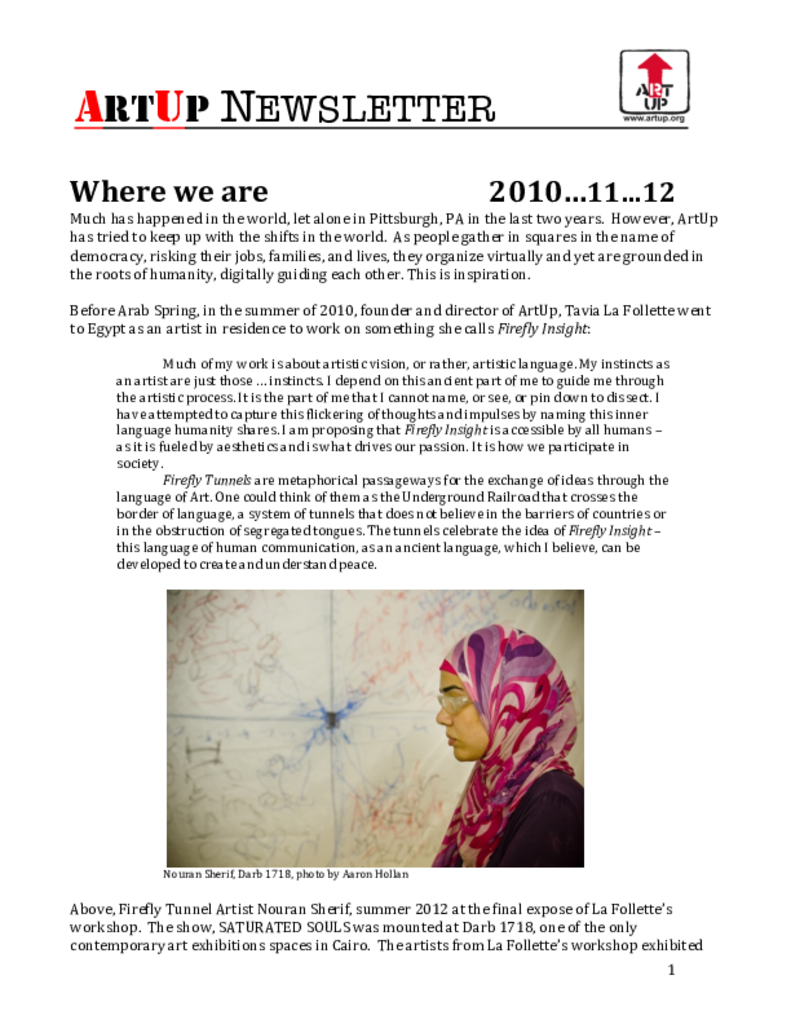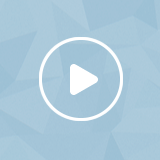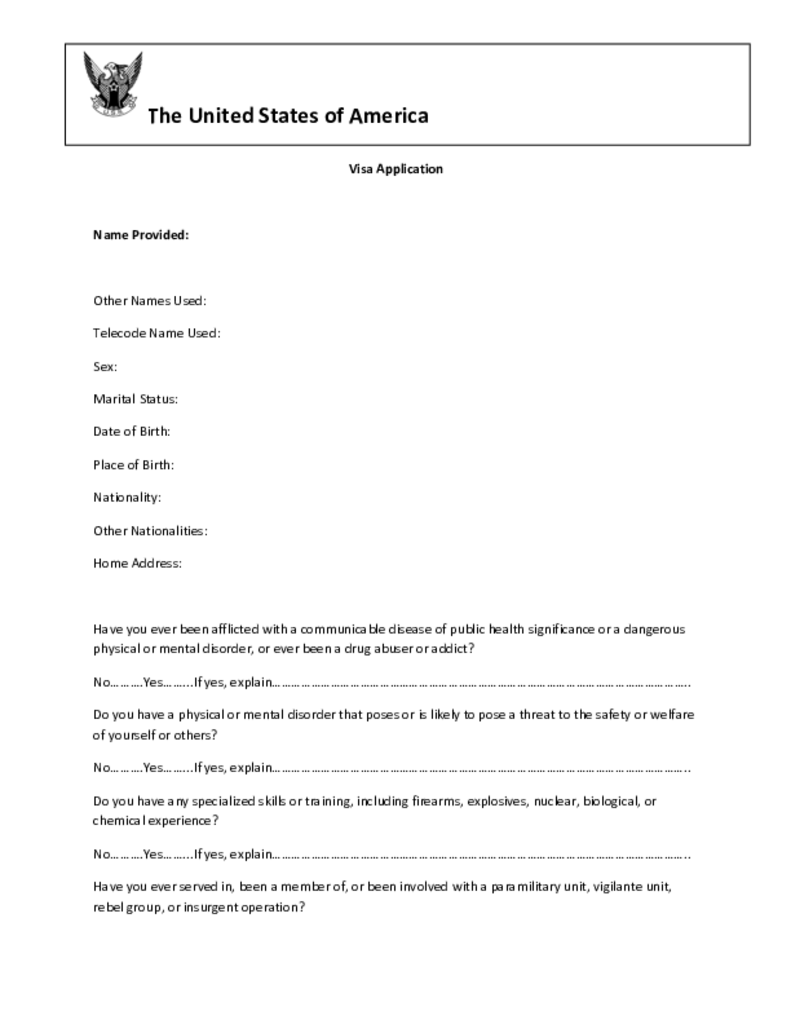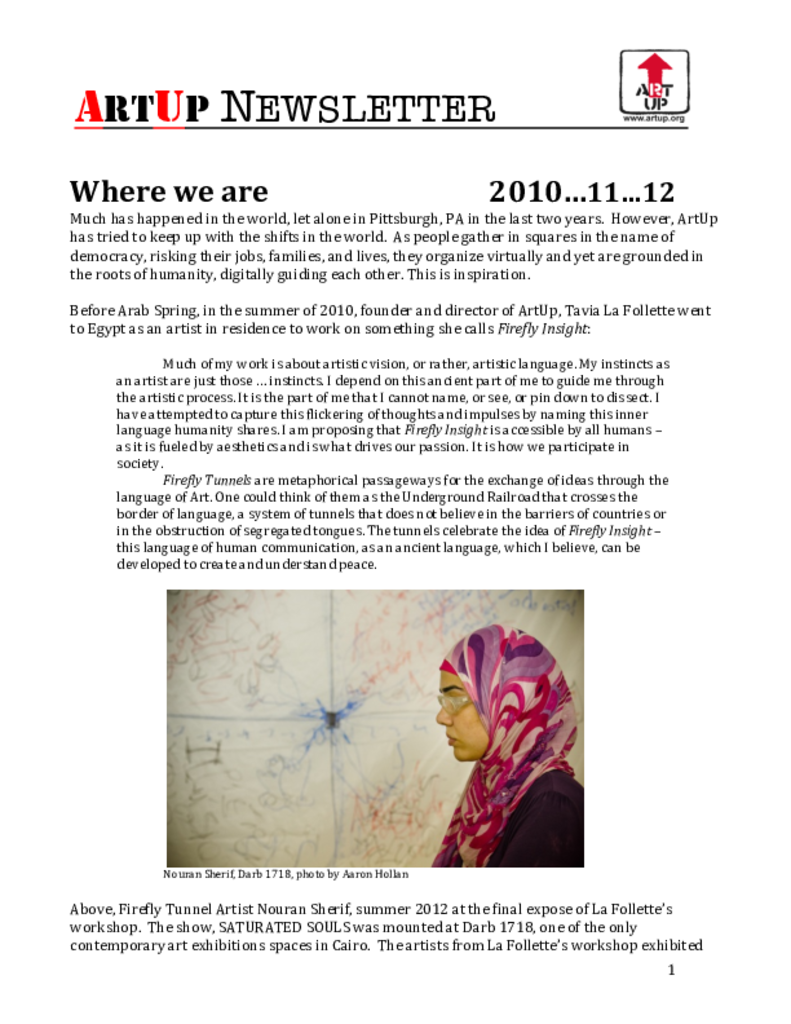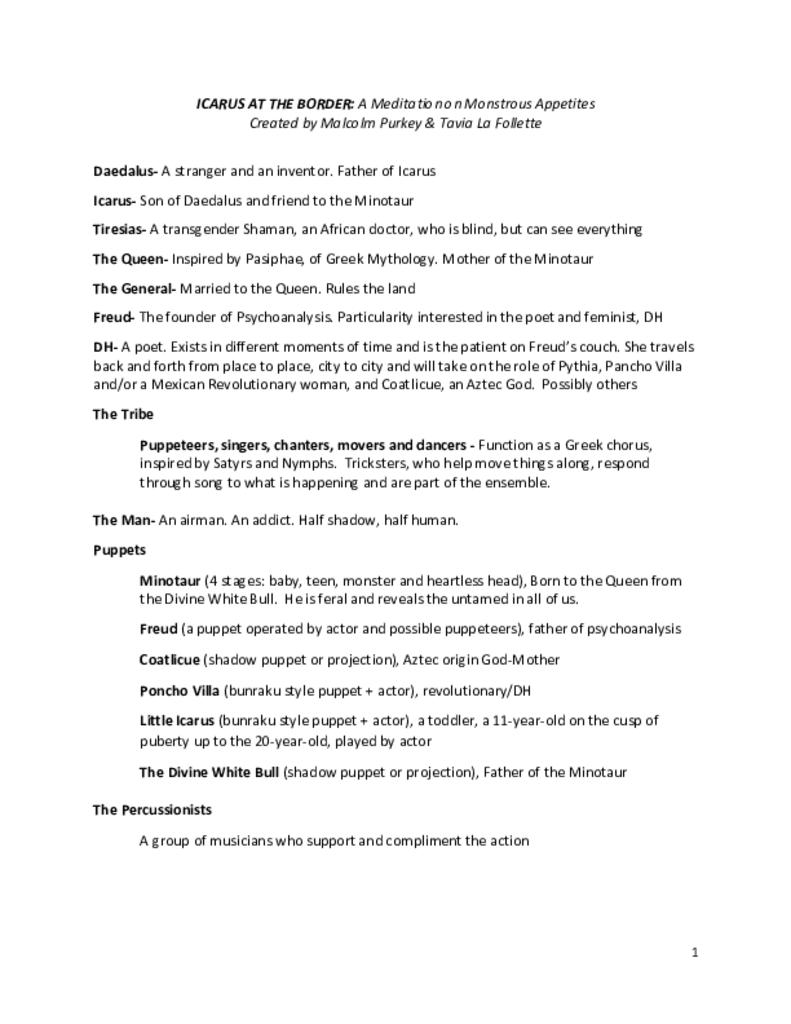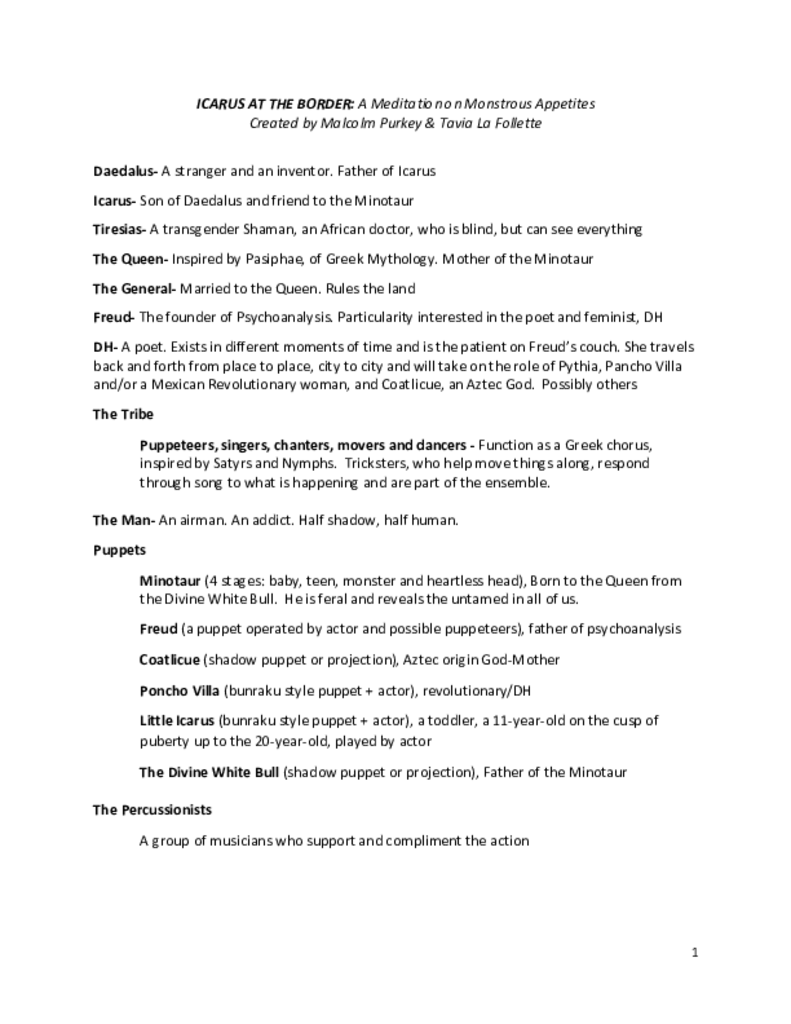Work samples
-
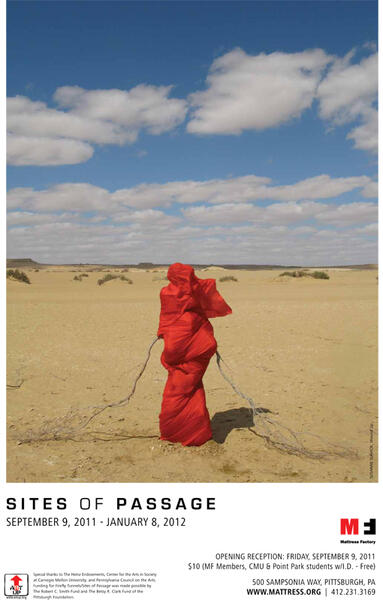 Red in the DesertAbove from: Red in the Desert, myself (lower) and the environmental Egyptian artist/activist, Sarah Rifaat This image is from the 1st Sites of Passage (SOP) project between Egypt and the US. I have included all 4 in my portfolio. Each project takes 2-3 years to execute. The Egyptian SOP began with the knowledge that the 10th anniversary of 911 was coming. I wanted to create an artistic exchange between a Muslim based country and the US. We embarked on the project pre-revolution. Amidst the exchange-- grew Arab Spring in Egypt and The Occupy Movement here in the States. This, of course, made the project even more politically charged.
Red in the DesertAbove from: Red in the Desert, myself (lower) and the environmental Egyptian artist/activist, Sarah Rifaat This image is from the 1st Sites of Passage (SOP) project between Egypt and the US. I have included all 4 in my portfolio. Each project takes 2-3 years to execute. The Egyptian SOP began with the knowledge that the 10th anniversary of 911 was coming. I wanted to create an artistic exchange between a Muslim based country and the US. We embarked on the project pre-revolution. Amidst the exchange-- grew Arab Spring in Egypt and The Occupy Movement here in the States. This, of course, made the project even more politically charged. -
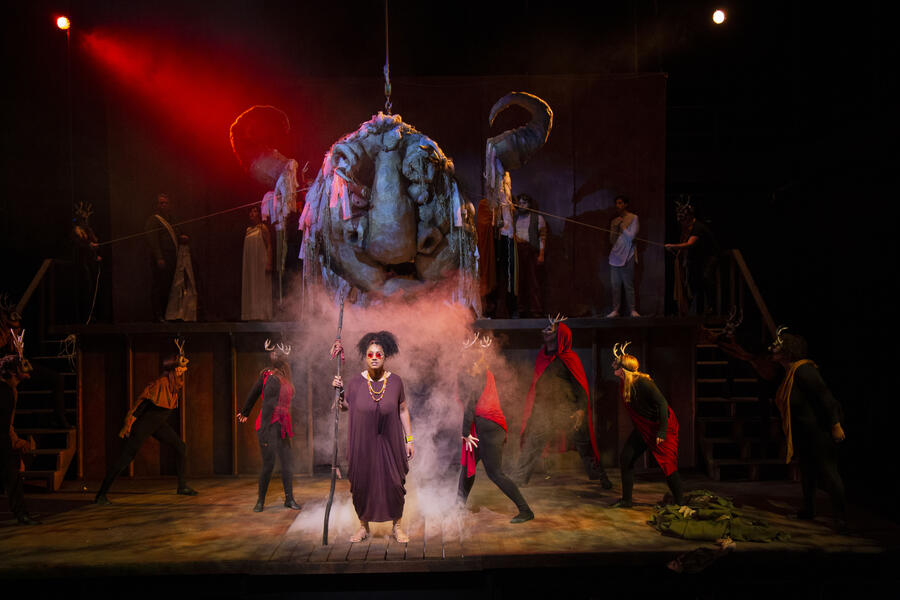 Tiresias and the MinotaurICARUS AT THE BORDER: a meditation on monstrous appetites. This is an image from the final scene of the play I co-wrote & co-directed with South African artist, Malcolm Purkey. I also designed all the puppets and masks for this workshop production which premiered at Towson University, November 2019.
Tiresias and the MinotaurICARUS AT THE BORDER: a meditation on monstrous appetites. This is an image from the final scene of the play I co-wrote & co-directed with South African artist, Malcolm Purkey. I also designed all the puppets and masks for this workshop production which premiered at Towson University, November 2019. -
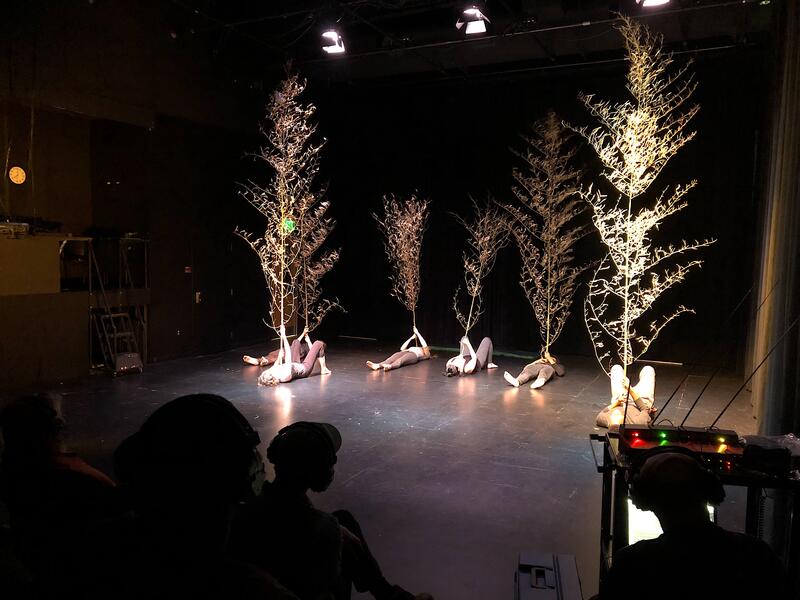 Dryer Lab- Baltimore perforamnceAncient Instincts: Performance meets Auditory Neuroscience. Above is an image of the performance in Baltimore. Here, one can see the audience perceiving what they are all seeing-- differently-- as they listen to seperate soundscapes which will impact the interpretation of the same performance.
Dryer Lab- Baltimore perforamnceAncient Instincts: Performance meets Auditory Neuroscience. Above is an image of the performance in Baltimore. Here, one can see the audience perceiving what they are all seeing-- differently-- as they listen to seperate soundscapes which will impact the interpretation of the same performance. -
The Lemonade ProjectThe Lemonade Project is a water quality venture with kids and lemonade stands. But these are no ordinary lemonade stands! These kids have evaluated the water from various socio-economical neighborhoods and priced the lemonade according to the water quality. This is one of my projects from Carnegie Mellon's CREATE Lab, out of the Robotics Institute. And I have now brought The Lemonade Project to Baltimore. See the Facebook site, images and our movie-- coming out soon!
About Tavia
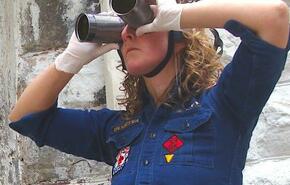
Tavia La Follette, PhD, is the founding director of ArtUp a non-profit where she runs Sites of Passage, global interchanges for the migration of ideas across political/cultural borders. As a professional who uses “Arts as Social Practice” as a medium to enter her work, La Follette’s practices are implemented at both a macro and micro level,… more
The First Site of Passage: Egypt & US
Sites of Passage projects are global interchanges for the migration of ideas across political/cultural borders.
Like the name alludes to, Sites of Passage, asks each artist to take a rite of passage. Exchanges take place between the Unites States and another country, around a topic of contention. The idea is to take the conversation away from the media and the politicians, who often have a very different agenda than the people. SOP gives the conversation to the artists to chew on. Artists spend time together, on the ground in both countries and out of that dialogue a final exhibition and performance series is produced.
I have included each of the SOP projects in my portfolio along with a newsletter that documents the process. I respectfully ask the panel to briefly scan through each newsletter, as it tells the unique tale of each endeavor. Every exchange takes about three years to execute, as one cannot go into these projects in a naïve manner. It takes time to research, travel, fundraise and spend time one the ground with the people, to understand the complexities at hand and select the most appropriate artists to go in this journey with me.
In conjunction with The Mattress Factory Museum (MF), previous exchanges have taken place between Egypt and the US (revolving around the Egyptian Revolution and the Occupy Movement), Israel, Palestine and the US (revolving around the ideas of Borders, Walls and Citizenship) and South Africa and the US (revolving around Civil Rights and Civil Wrongs). These cultural and collaborative dialogues include voices from a variety of artistic practices.
I am currently in the middle of the 4th SOP projects, Pop-Aganda: Revolution & Iconography. This project is between Russia and the US and will open at the MF museum in the summer of 2021.
And I have already begun preliminary research for the 5th SOP via another project, First Fulbright (see portfolio). This 5th SOP will link indigenous cultures together. I have found that each project leads to the next. I follow a trail of “Art as Social Practice” bread crumbs, from one project to the next. We are all connected.
www.sitesofpassage.org
-
Sites of Passage - the workshopsFor each Sites of Passage project, artists go through a workshop with me, revolving around the power of image, site and ritual. This give us a basic language to communicate with. This is extremely helpful, especially when there are language,cultural and religious barriers between us. We learn to speak through Metaphor, from Greek, meaning to transport.
-
Passport Agency Final Edit copyThis is documentation from the opening. It was hard to get Egyptians into the US, when they were have a revolution and we were amidst the Occupy Movement. We had to open the show without them and send all the work digitally. I wanted the audience to get a sense of how difficult it is to get into the US with or without a revolution. So, I created a mock US Embassy at the front of the exhibit, where all viewers were "processed" in some way and gained access to the absurd questions asked during the US visa process. We eventually got all the Egyptians in to the US. The full story can be seen with images in the next segment via the newsletter.
-
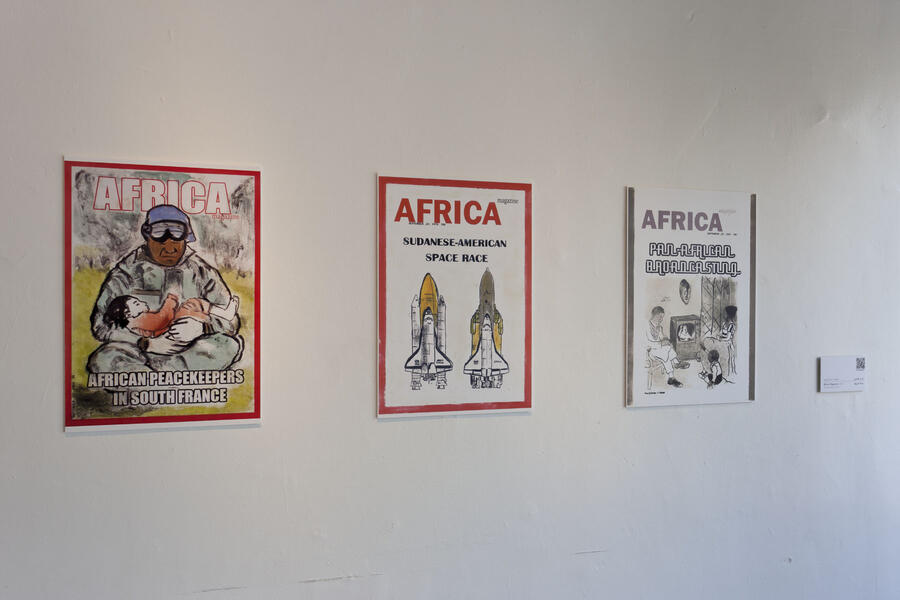 Amado Al Fadni, Africa as a first world nationAmado Al Fadni, designed "TIME MAGAZINE" like covers, which imagine Africa as a first world nation.
Amado Al Fadni, Africa as a first world nationAmado Al Fadni, designed "TIME MAGAZINE" like covers, which imagine Africa as a first world nation. -
1. reduced-Sites of Passage- A revolution.pdfThis is the first Sites of Passage newsletter and eventually what I wrote my dissertation on, "SITES OF PASSAGE: Art as Action in Egypt and the U.S.—Creating an Auto-ethnography through Performance Writing, Revolution, and Social Practice", defended on January 19th, 2013, Antioch University, Seattle. These newsletters document each one of the SOP projects from beginning to end. After my 5th SOP, between indigenous artists, I would like to put together a book proposal.
-
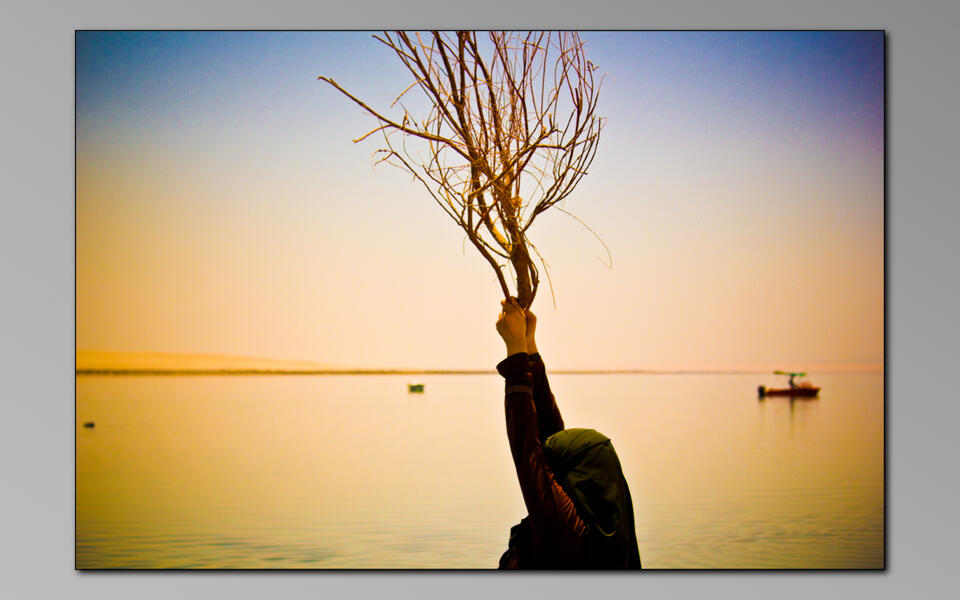 Instant human installations and learning to document our work, Fayoum, EgyptInstant human installations and learning to document our work, Fayoum, Egypt
Instant human installations and learning to document our work, Fayoum, EgyptInstant human installations and learning to document our work, Fayoum, Egypt -
Mostafa Sleem, The Sound of SoundMostafa Sleem's first attempt at making a video from our time together in the pre-revolutionary Egypt workshop. He was primarily a painter and never worked digitally before. Part of the reason was lack of access to tools and education. I believe this work taps into some of the deep topics we wrestled with as group, living and working so closely together. “The video depicts what happened with us, all of us in that workshop. When you grow your sprit up and go through the others, then go deep inside your emotions, and you own culture and dreams… that you looking for. Humanity is a raw material like the colors and sound and the inside space. This is what makes you the challenger of yourself.
-
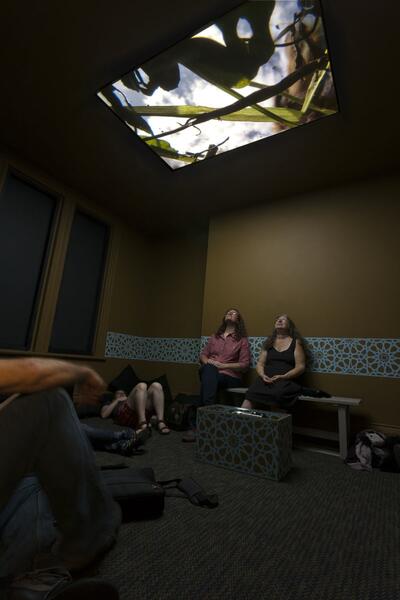 Visitors interacting with the workVisitors interacting with the work
Visitors interacting with the workVisitors interacting with the work -
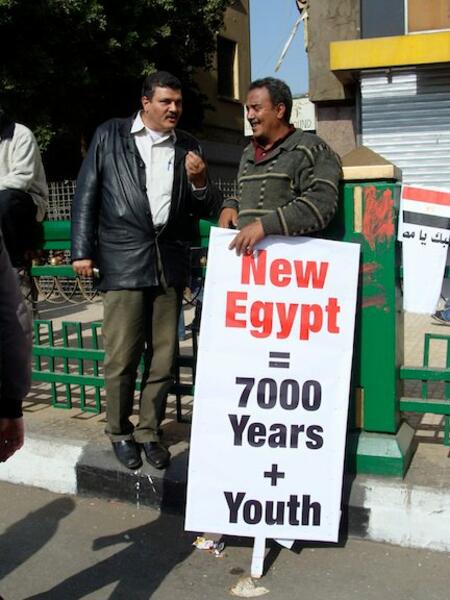 Tahir Square: a revolution for a new EgyptTahir Square: a revolution for a new Egypt
Tahir Square: a revolution for a new EgyptTahir Square: a revolution for a new Egypt -
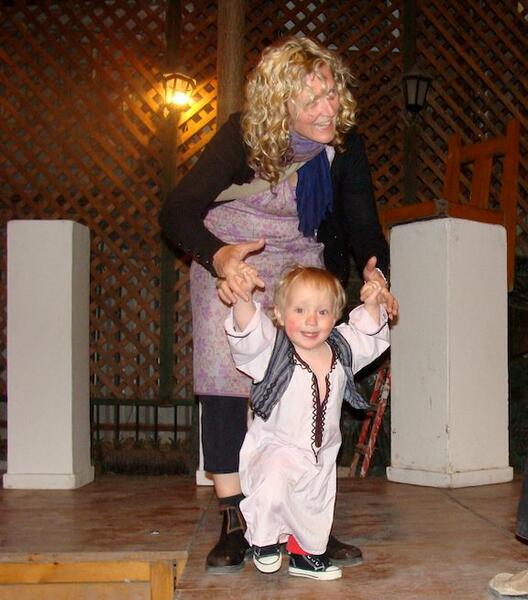 Raising children is an artRaising children is an art. People are surprised to hear I take my children with me to these places of conflict. But there are children everywhere I go. I don't want my kids to be afraid of other humans.
Raising children is an artRaising children is an art. People are surprised to hear I take my children with me to these places of conflict. But there are children everywhere I go. I don't want my kids to be afraid of other humans.
ICARUS AT THE BORDER, a meditation on monstrous appetites
Imagine a monster in a cave, stamping and howling for food. Imagine he is not a monster, has mother queen who loves him madly. Imagine Daedalus in his laboratory, like some early Da Vinci, designing the first flying machines. Imagine a very young Icarus watching.
Imagine the first airplanes and disputed borders.
Imagine Freud with the Mother Queen on his couch.
Imagine Tiresias, a transgender witchdoctor who is blind…but can see everything.
Imagine that same seer, at the Oracle of Delphi, his nose pushed into the magic crack in the Greek mountain, inhaling the sweet, dangerous, addictive and wondrous smoke.
Imagine the monster and Icarus, enamored, dancing to the same smoke. Imagine Icarus, triumphant, riding on the monster at midnight. Imagine the monster howling with burdensome delight.
Imagine the first airmen of the USA air force, in their clumsy biplanes, destroying the hopes of the Mexican revolutionaries.
Imagine flying insects that are subservient to generals, detonating cultures and generations, viewed through a portal in time. Image the sky on fire.
Imagine the histories of war in the name of gods, and the medicines used to ease those memories.
ICARUS AT THE BORDER was workshopped at Towson University (TU) on the fall of 2019 in Baltimore, Maryland through the COFAC (College of Fine Arts & Communications) new CoLab Initiative. CoLab is a pivot point and a catapult over disciplinary and cultural borders. Designed as a space where fields of study are porous and contemporary cultures are created, the objective is to build new knowledge for an ever-evolving world.
Tavia La Follette is the co-deviser with Malcolm Purkey, South African director and the first CoLab Fellow. Purkey has worked with The Hand Spring Puppet Company and La Follette worked with Bread and Puppet (and associates) since the mid 90s in NYC. Award winning help comes from—the percussionist, Michelle Humphreys (Music); and dramaturgy by Greek Specialist (head of the Masters in Global Humanities program), Jennifer Ballengee, plus Baltimore based artist Katherine Fahey and her shadow puppet projections.
The show was developed/workshopped at the university via the Department of Theatre Arts and CoLab. Through a residency process, guest artists, students and faculty came together to produce this first incarnation.
-
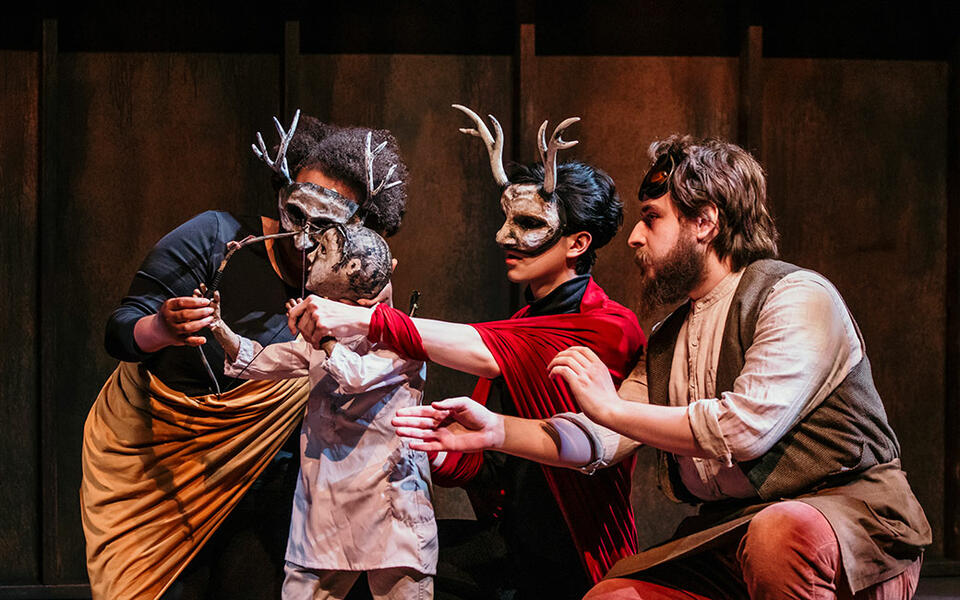 Little IcarusLittle Icarus (small bunraku puppet) learns from his father Daedalus (with the help from Puppeteers/Satyrs/Greek Chorus), how to shoot an arrow into Tiresias' bottom!
Little IcarusLittle Icarus (small bunraku puppet) learns from his father Daedalus (with the help from Puppeteers/Satyrs/Greek Chorus), how to shoot an arrow into Tiresias' bottom! -
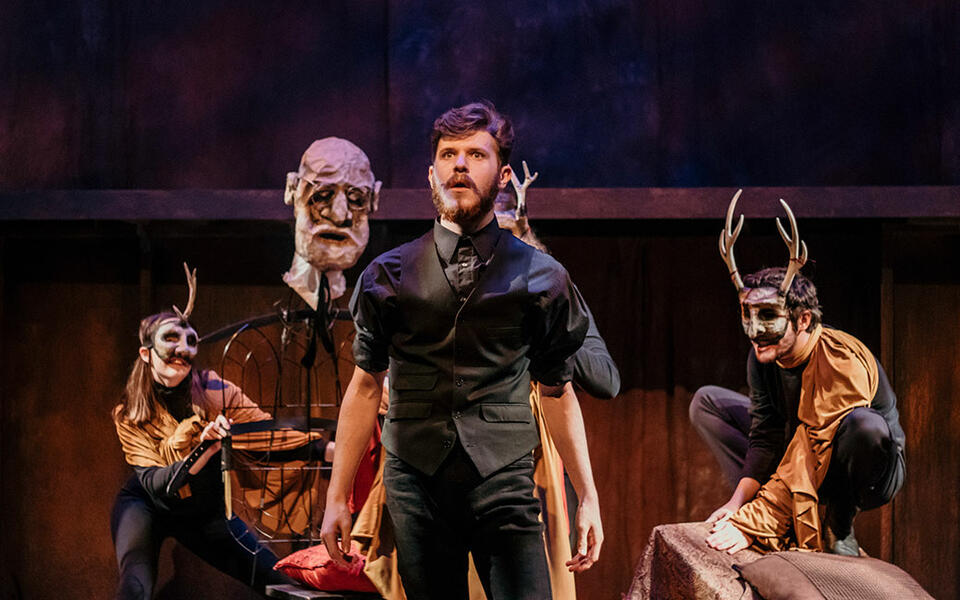 De-masking of Satyr ritual to become Freud puppetA ritual dance to choose a Satyr to get strapped into the Freud puppet.
De-masking of Satyr ritual to become Freud puppetA ritual dance to choose a Satyr to get strapped into the Freud puppet. -
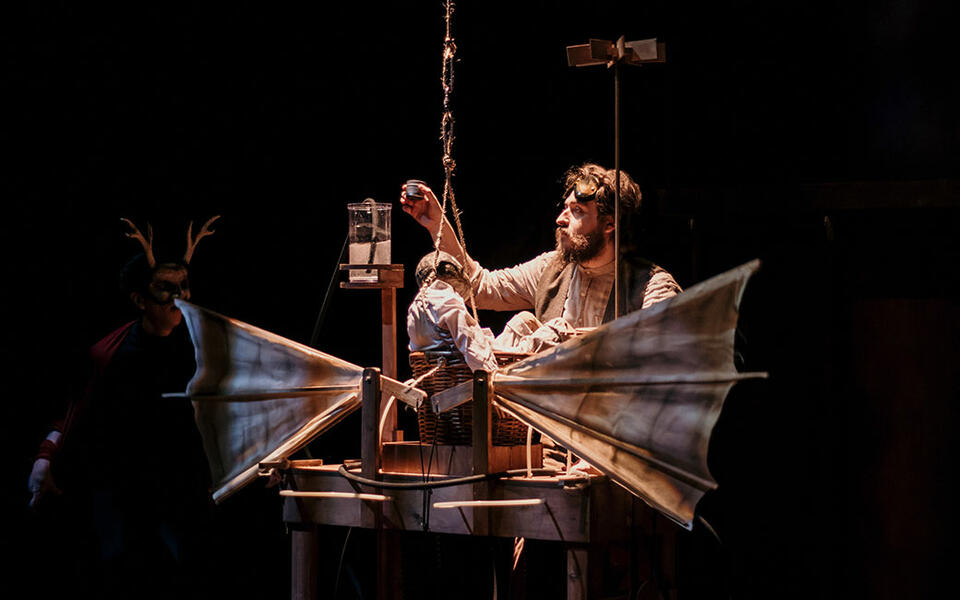 Daedalus, little Icarus and the flying machineDaedalus helps little Icarus into his invention--the flying machine. This starts Icarus on his own obsession with getting high.
Daedalus, little Icarus and the flying machineDaedalus helps little Icarus into his invention--the flying machine. This starts Icarus on his own obsession with getting high. -
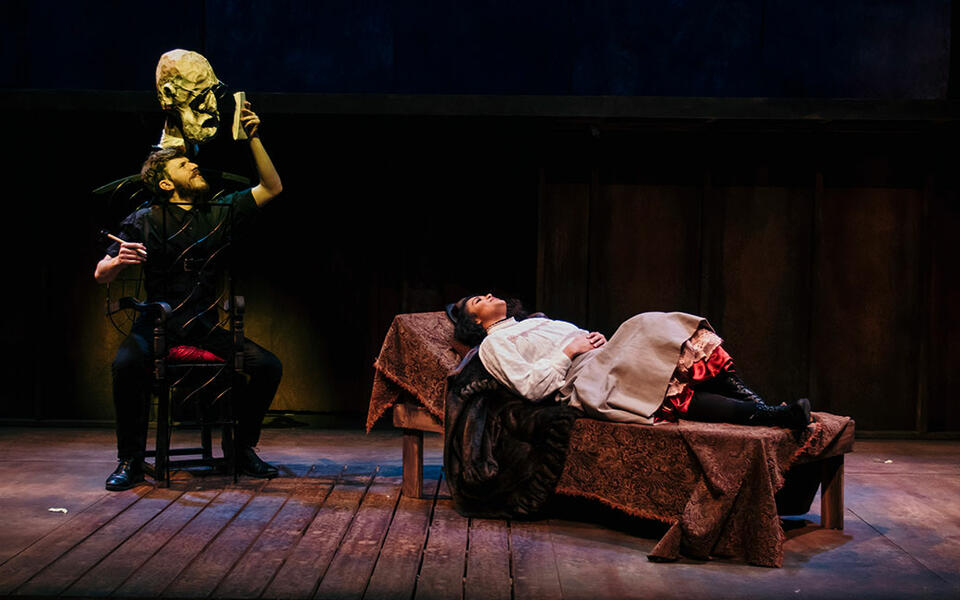 Freud and D.H. on the couchFreud is fascinated by his protege, D.H. who is a poet and has the ability to hypnotize herself and travel through time. She uses Freud's couch as a portal, or a flying carpet to her reincarnated self, originating as Pythia, the the high priestess of the Temple of Apollo at Delphi who also served as the oracle, also known as the Oracle of Delphi.
Freud and D.H. on the couchFreud is fascinated by his protege, D.H. who is a poet and has the ability to hypnotize herself and travel through time. She uses Freud's couch as a portal, or a flying carpet to her reincarnated self, originating as Pythia, the the high priestess of the Temple of Apollo at Delphi who also served as the oracle, also known as the Oracle of Delphi. -
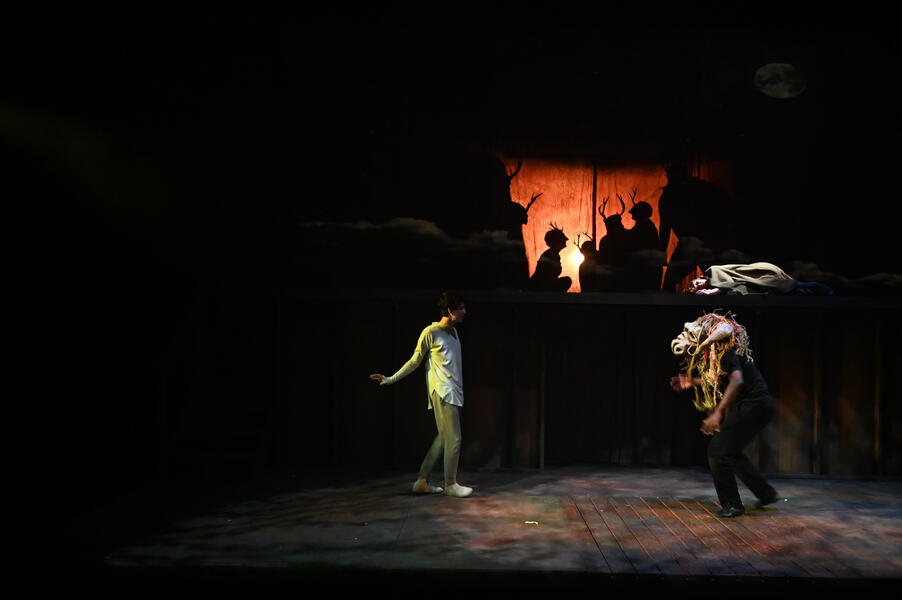 Icarus dances with and tames the MinotaurIcarus dances with and tames the Minotaur. The Satyrs singing a narration in silhouette. They act as a traditional Greek Chorus.
Icarus dances with and tames the MinotaurIcarus dances with and tames the Minotaur. The Satyrs singing a narration in silhouette. They act as a traditional Greek Chorus. -
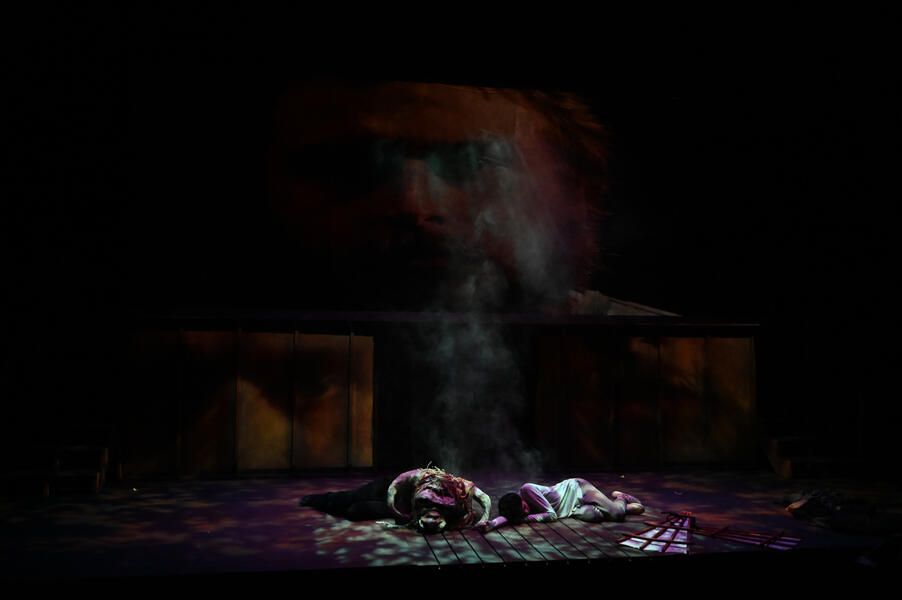 Icarus and the Minotaur are in a deep sleep at Delphi, after inhaling the magic smoke, Icarus is haunted by his father in a dream.Icarus and the Minotaur are in a deep sleep at Delphi, after inhaling the magic smoke, Icarus is haunted by his father in a dream.
Icarus and the Minotaur are in a deep sleep at Delphi, after inhaling the magic smoke, Icarus is haunted by his father in a dream.Icarus and the Minotaur are in a deep sleep at Delphi, after inhaling the magic smoke, Icarus is haunted by his father in a dream. -
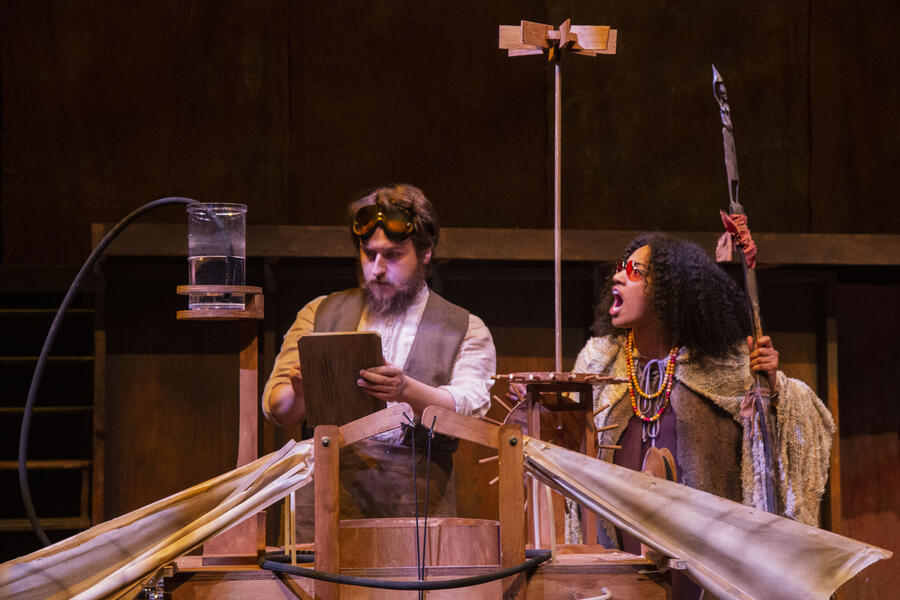 Tiresias and Daedalus, arguing like and old married coupleTiresias and Daedalus, arguing like and old married couple. They have know each other forever and traveled to this new land together. They are immigrants who are misunderstood and bound together for life.
Tiresias and Daedalus, arguing like and old married coupleTiresias and Daedalus, arguing like and old married couple. They have know each other forever and traveled to this new land together. They are immigrants who are misunderstood and bound together for life. -
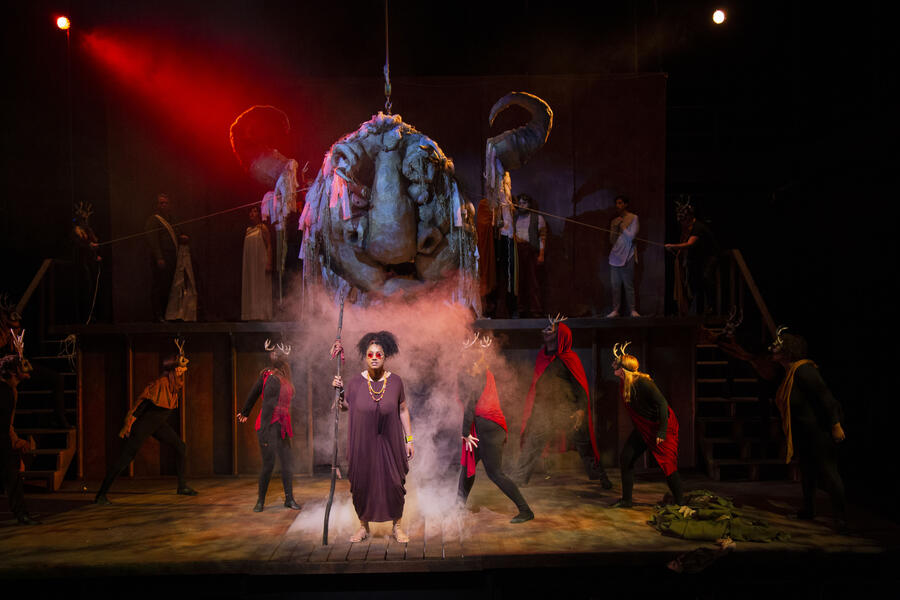 Tiresias and the Minotaur with the Satyrs.Final scene: Tiresias and the Minotaur with the Satyrs. Tiresias explains, “The minotaur lives on without a heart, as humanity inhales our next god”.
Tiresias and the Minotaur with the Satyrs.Final scene: Tiresias and the Minotaur with the Satyrs. Tiresias explains, “The minotaur lives on without a heart, as humanity inhales our next god”. -
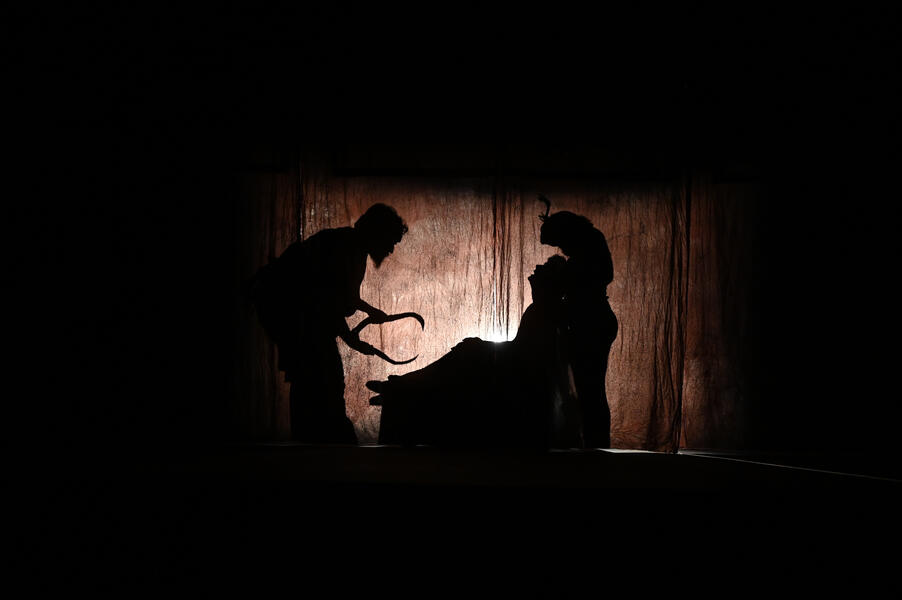 Minotaur birthThe Queen, pregnant by the White Bull God, needs Daedalus’ help to birth the Minotaur.
Minotaur birthThe Queen, pregnant by the White Bull God, needs Daedalus’ help to birth the Minotaur.
Ancinet Instincts: Art meets Auditory Neuroscience
WHAT
Performance has the capacity to take shared moments and convert them into a liminal passageway in which communities share a common catharsis. In this project, we are trying to accomplish the opposite. At the endof the performance, having just gone through the very same experience, the aim is to have the audiencedecipher different conclusions, sharing contrasting cognitive responses.
Perception: By isolating the auditory experience through individual headphones, the goal is to design 4 different auditory systems in which to perceive the one visual show. The systems consist of 4 soundscapesthat are in tandem with the images and movements on stage. Traditionally in theatre, sound is one of the lastlayers. In this method, we bring sound into the process at the very beginning, similar to choreography.
Mapping: The project does not want to get lost in a montage of vague experienced moments. We build one movement/object/sound piece at a time:
1. Genesis (or post apocalypse)
2. Separation of Human from Nature
3. Separation of Human from Human
4. Separation of Humanity from Technology (or pro apocalypse).
WHY
Auditory Neuroscience: Inspired by Seth Horowitz’s research* where he argues, “Everything you hear has some sort of impact on you and changes how you respond to the rest of the world. Sound provides context. It is able to give us the basis for a lot of very complex cognitive responses”.
Why Now? This is a first step towards larger research where we invite cultural evolutionists, psychologists, anthropologists and neuroscientist to join us. In a world where science and arts are being ignored because it doesn’t fit a political/economic agenda, this cross-disciplinary work is key.
Vertical Migration of Thought: Horizontal Hierarchy is not of interest to this project. Isolated privileged interpretations defeat the purpose of the research. Therefore, it is critical that voices from those who experience economic apartheid, environmental injustice, critical race, sexuality and gender rights issues come into the conversation.
The aim of this performative research is to investigate systems of institutionalized or cultural perceptions. Every human is shaped by the cultural heritage they are born into. Science, Arts and Imagination allow us to creatively travel beyond that world. However, Media shapes our concept of the world outside our cultural comfort zone. Imagine if your sensory memory is your only guide through the program. Participate in a talk-back where you critique your own neurological filing system—reconsidering the perceiving process of how to comprehend the world around you.
* The Universal Sense-How Hearing Shapes the Mind
ARTISTIC CONSIDERATIONS
Each one of us is a complex atlas of genetic information, mapping out the migration of our ancient ancestors. As humans physically evolve, so does our consciousness and our challenges to exist. Therefore, as scientists begin to piece together humanity’s origin story via DNA/fossils, and old ideas of creation and race are proven false—how do we, as culture and meaning makers play a role in the migration of thought?
This project was made possible by The Ruby Award and the help of CoLab (directed by La Follette) and its CALL TO KNOWLEDGE: https://www.towson.edu/cofac/centers/colab/
To view Ancient Instincts via the soundscapes (designed by Scott Patterson) visit:
https://ancient-instincts.wixsite.com/ancientinstincts
-
 Ancient Instincts Dryer Lab- Baltimore performanceHere, one can see the audience viewing the performance wearing headphones.
Ancient Instincts Dryer Lab- Baltimore performanceHere, one can see the audience viewing the performance wearing headphones. -
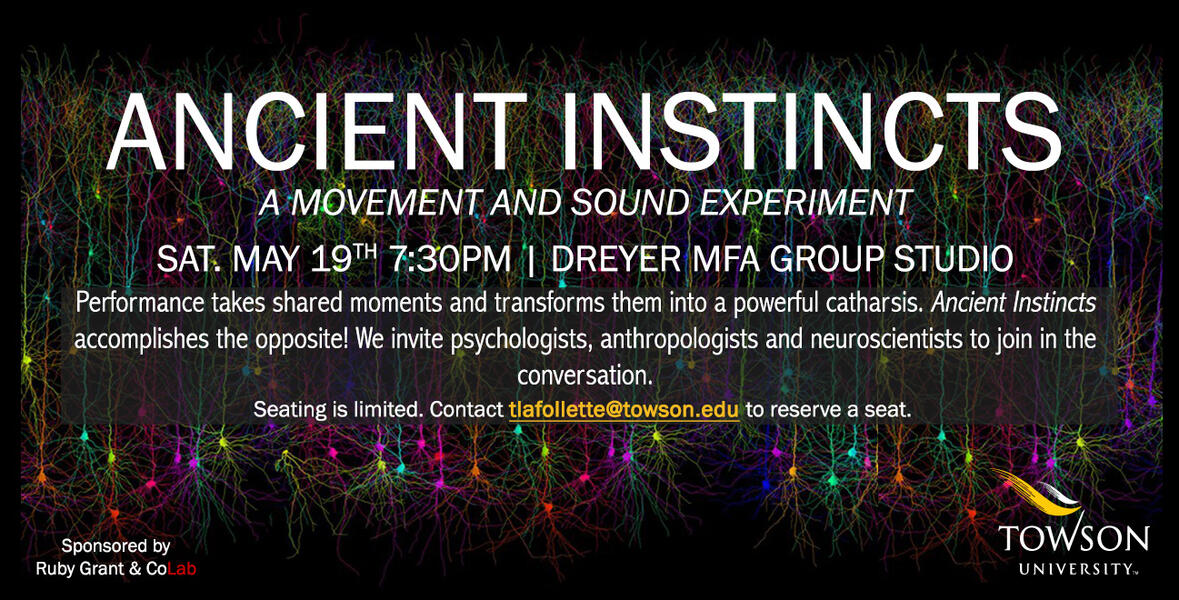 ANCIENTINSTINCTS postcardThis is the postcard used to invite people to the Baltimore show.
ANCIENTINSTINCTS postcardThis is the postcard used to invite people to the Baltimore show. -
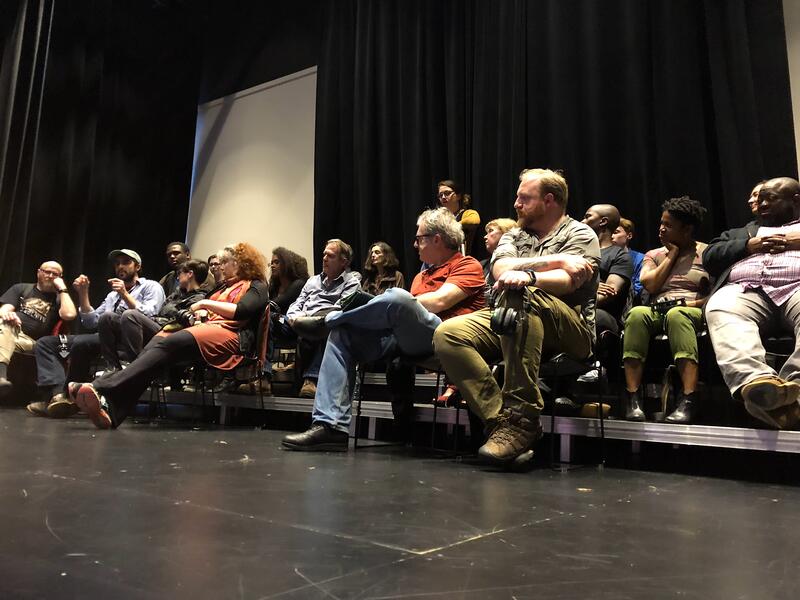 Ancient Instincts talk-back, BaltimoreHere is an image of the audience during the talk back sharing their individual interpretations of the experience. All the artists were in the room, including the performers and Scott Patterson, who deseigned the soundscapes.
Ancient Instincts talk-back, BaltimoreHere is an image of the audience during the talk back sharing their individual interpretations of the experience. All the artists were in the room, including the performers and Scott Patterson, who deseigned the soundscapes. -
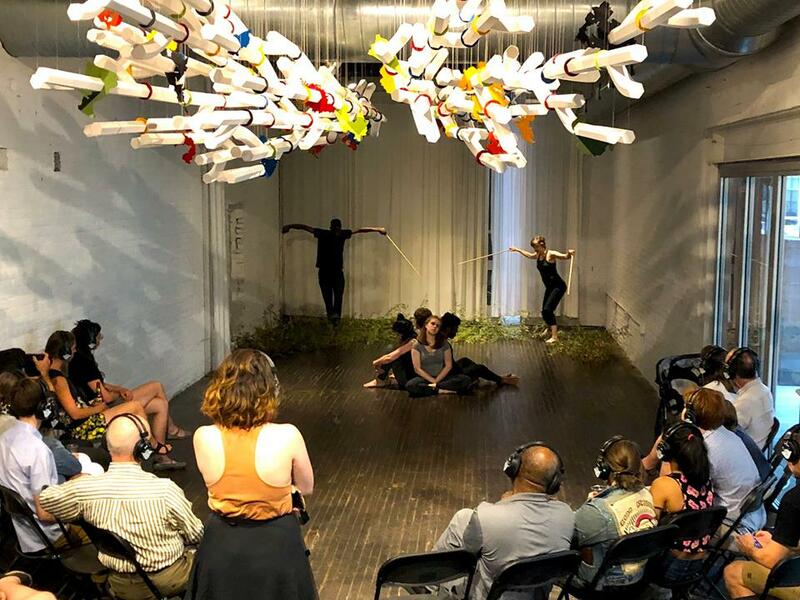 Ancient Instincts in PittsburghAncient Instincts was able to travel to Pittsburgh, PA and be performed & installed at the Mattress Factory Museum.
Ancient Instincts in PittsburghAncient Instincts was able to travel to Pittsburgh, PA and be performed & installed at the Mattress Factory Museum. -
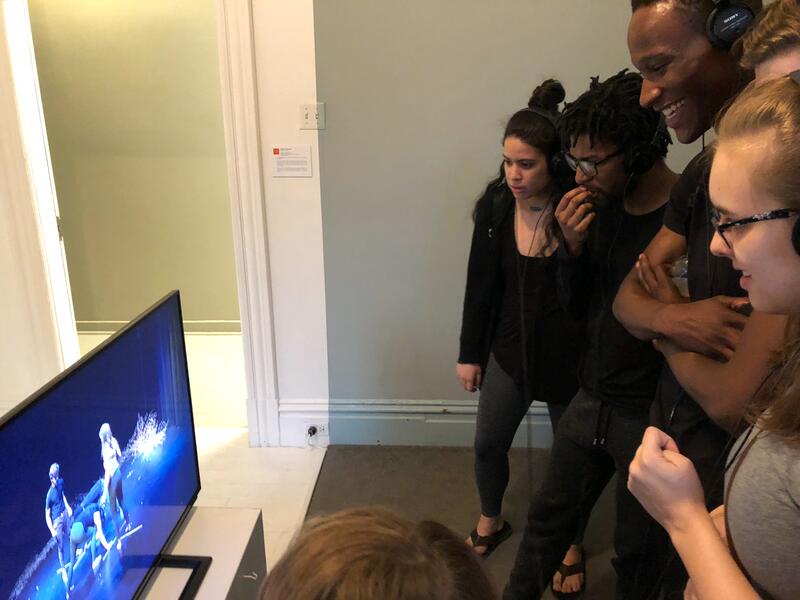 Ancient Instincts- performers finally hear!The performance that happened in Baltimore, was documented and installed in Pittsburgh with the various sound tracks. I didn't let the performers hear the sound track until they were finished with all the performances. This is a picture of the performers hearing the various soundscapes that they have been working on-- for the first time.
Ancient Instincts- performers finally hear!The performance that happened in Baltimore, was documented and installed in Pittsburgh with the various sound tracks. I didn't let the performers hear the sound track until they were finished with all the performances. This is a picture of the performers hearing the various soundscapes that they have been working on-- for the first time. -
Ancinet Instincts sample no soundThis is a section of the project with no sound. This is just to give the panel a sense of the performance. The website allows one to chose a sound scape and watch the whole performance: https://ancient-instincts.wixsite.com/ancientinstincts
The Lemonade Project
The Lemonade Project not only brews citizen scientists, it cultivates future environmental leaders and educators. The goal is to put up as many stands as possible throughout Baltimore to promote the project and water quality. We have built community partners to work with and from that documentation, a video will be made.
Environmental Engagement: The Lemonade Project utilizes the CATTFISH to measure the quality of water in different neighborhoods. We work with kids in different communities to create lemonade stands. But these are no ordinary lemonade stands! These kids have evaluated the water from various socio-economical regions (including their own) and the pricing of the lemonade will be set accordingly. Carafes of lemonade organized by regions (similar to wine), will be on display as a teach tool. Naïve passerbys who come to support a child’s financial endeavor—will instead receive a lecture on the environmental state of their surrounding neighborhoods!
The mission of the project is to enlighten and empower youth through the tools of science and art. Through a workshop/camp at Dr. Bernard Harris, Sr. Elementary School and The Refugee Youth Project, Towson University students worked with kids by researching, designing and constructing site specific, action art projects, which are driven by digital data collected with CREATE Lab tools (www.createlab.org ).
The Refugee Youth Project (RYP), an educational program housed under Baltimore City Community College, partners with Soccer Without Borders to run a full day International Summer Academy (ISA) from June 25th-August 5th. Since 2003, the RYP has served more than 5,000 newcomers through after-school, summer school, and mentoring programs.
Dr. Bernard Harris, Sr. Elementary School (http://www.baltimorecityschools.org) Serves the students and parents of the Oliver Community: 1400 N Caroline St, Baltimore, MD 21213
We have also worked with Port Discovery, Baltimore's Children’s' Museum and Towson University’s Center for STEM Excellence in Baltimore’s Inner Harbor.
Follow us on Facebook: https://www.facebook.com/thelemonadeproject/
-
The Lemonade ProjectThe Lemonade Project is a water quality venture with kids and lemonade stands. But these are no ordinary lemonade stands! These kids have evaluated the water from various socio-economical neighborhoods and priced the lemonade according to the water quality. This is one of my projects from Carnegie Mellon's CREATE Lab, out of the Robotics Institute. And I have now brought The Lemonade Project to Baltimore. See the Facebook site, images and our movie-- coming out soon!
-
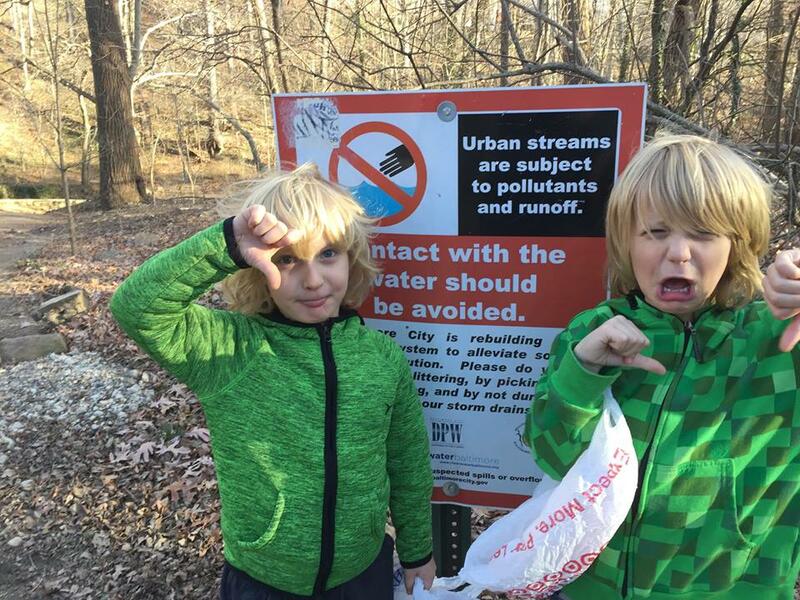 The Lemonade Project needs to come to BaltimoreWhen I moved to Baltimore from Pittsburgh and started to learn about all the water quality issues, here in the city-- I knew I had to bring The Lemonade Project to Baltimore. The image is a picture of my sons, Max and Calder very sad that they can't play in the stream that runs through the park right by our house in Baltimore City.
The Lemonade Project needs to come to BaltimoreWhen I moved to Baltimore from Pittsburgh and started to learn about all the water quality issues, here in the city-- I knew I had to bring The Lemonade Project to Baltimore. The image is a picture of my sons, Max and Calder very sad that they can't play in the stream that runs through the park right by our house in Baltimore City. -
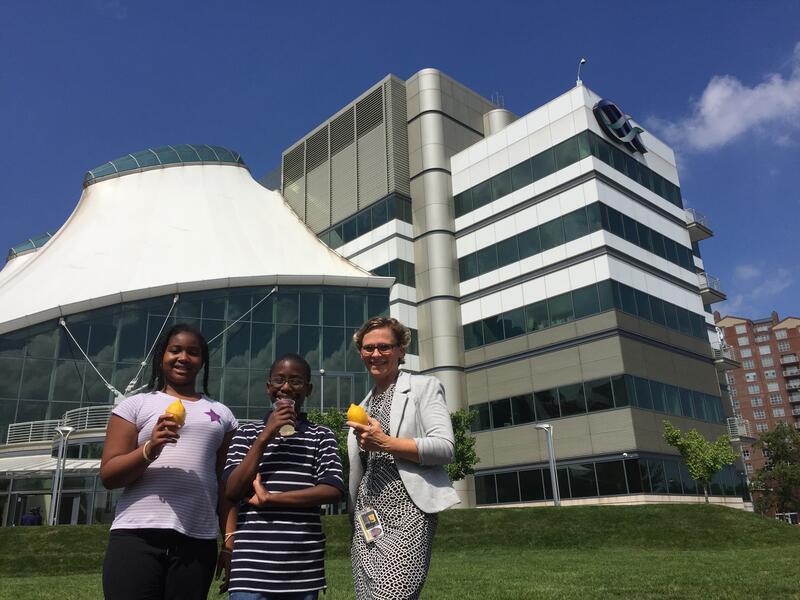 The Lemonade Project at the Inner HarborStetting up The Lemonade Project outside the TU Center for STEM excellence in the Inner Harbor.
The Lemonade Project at the Inner HarborStetting up The Lemonade Project outside the TU Center for STEM excellence in the Inner Harbor. -
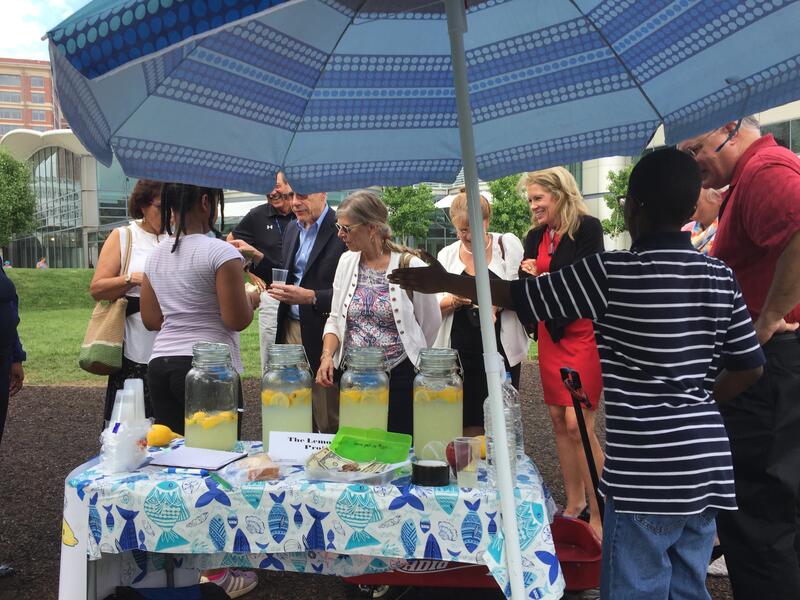 Towson University college Deans buy lemonade!The deans from all the colleges at Towson University were visiting the STEM Center, so-- they stopped by to buy some lemonade!
Towson University college Deans buy lemonade!The deans from all the colleges at Towson University were visiting the STEM Center, so-- they stopped by to buy some lemonade! -
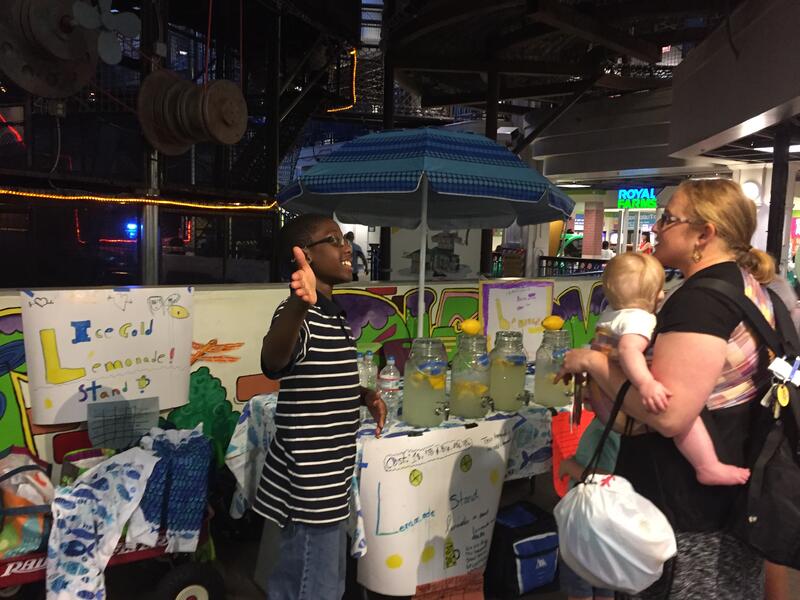 The Lemonade project at Port Discovery, the children's museumThe Lemonade Project was also at the Baltimore Children's Museum, Port Discovery!
The Lemonade project at Port Discovery, the children's museumThe Lemonade Project was also at the Baltimore Children's Museum, Port Discovery! -
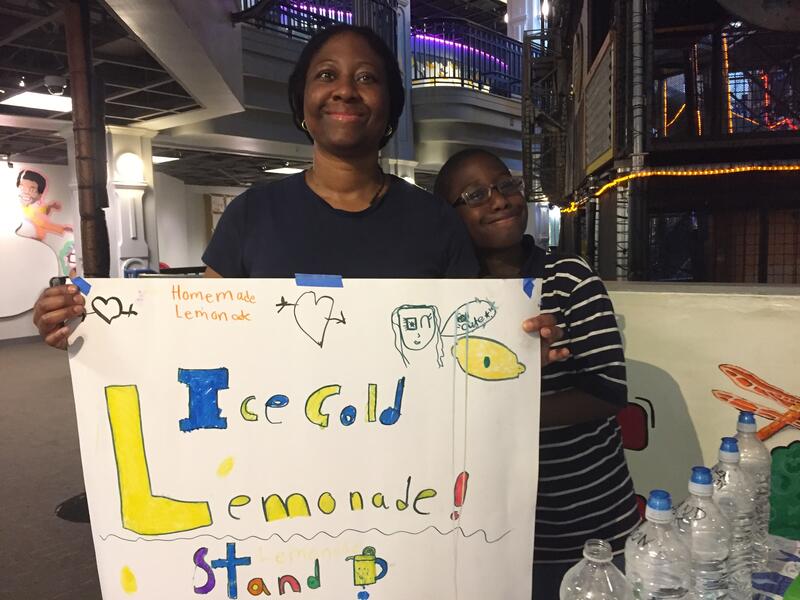 Proud Mama!A proud mama came by to see her son in action at the museum.
Proud Mama!A proud mama came by to see her son in action at the museum. -
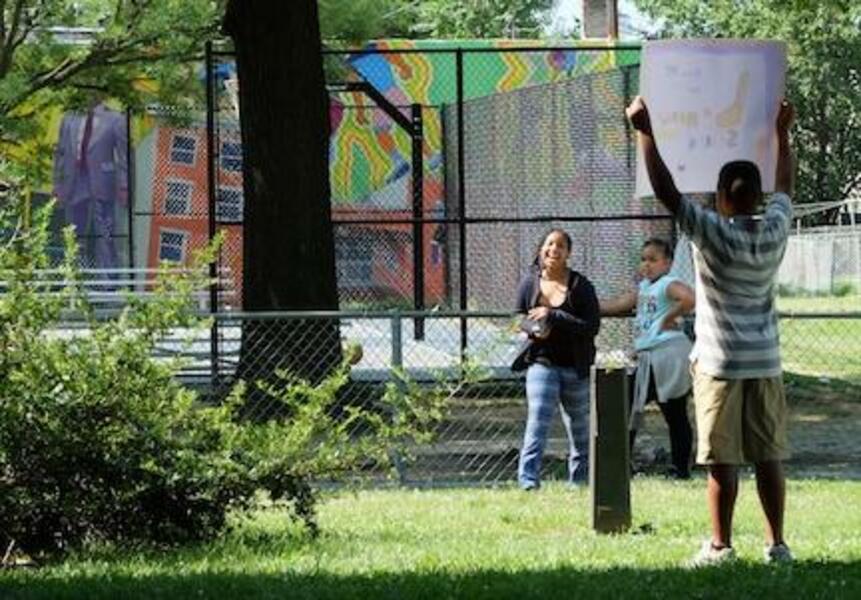 Oliver District, East Baltimore, Dr. Bernard Harris Elementary SchoolRallying customers for The Lemonade Project, Oliver District, East Baltimore, Dr. Bernard Harris Elementary School
Oliver District, East Baltimore, Dr. Bernard Harris Elementary SchoolRallying customers for The Lemonade Project, Oliver District, East Baltimore, Dr. Bernard Harris Elementary School -
The Lemonade Project at The Three Rivers Arts Festival, SPROUT FUND tent, Pittsburgh, PAThe Lemonade Project at The Three Rivers Arts Festival, SPROUT FUND tent, Pittsburgh, PA
-
The Lemonade Project at the University of PittsburghThe Lemonade Project at the University of Pittsburgh
-
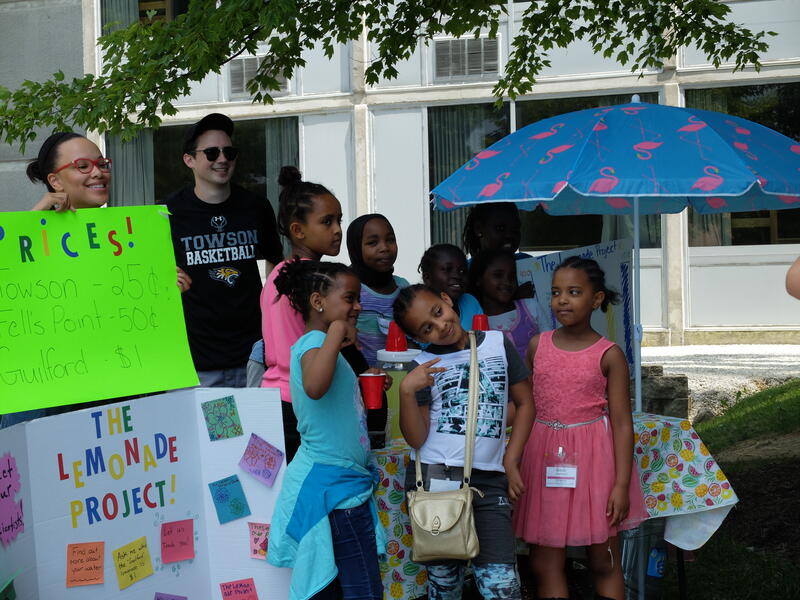 The Refugee Youth Project take the Lemonade Project to Towson UniversityThe Refugee Youth Project takes the Lemonade Project to Towson University
The Refugee Youth Project take the Lemonade Project to Towson UniversityThe Refugee Youth Project takes the Lemonade Project to Towson University
Sites of Passage- BORDERS, WALLS & CITIZENSHIP: Palestine, Israel and US
This 2nd Sites of Passage takes artists from three countries: Palestine, Israel, and the United States and places them together to discuss BORDERS, WALLS and CITIZENSHIP. These three words are charged and resonate in all three regions.
The artistic dialogue occurs through a virtual and tangible art exchange process. The physical and web-based points of intersection are key to the methodology of the exchange. The practice of placing these artists in a shared space assures that 1) physical, emotional, and psychological boarders will be crossed, 2) they will have gone through a shared/common experience, and finally 3) that an artistic dialogue will take place around the above issues.
-
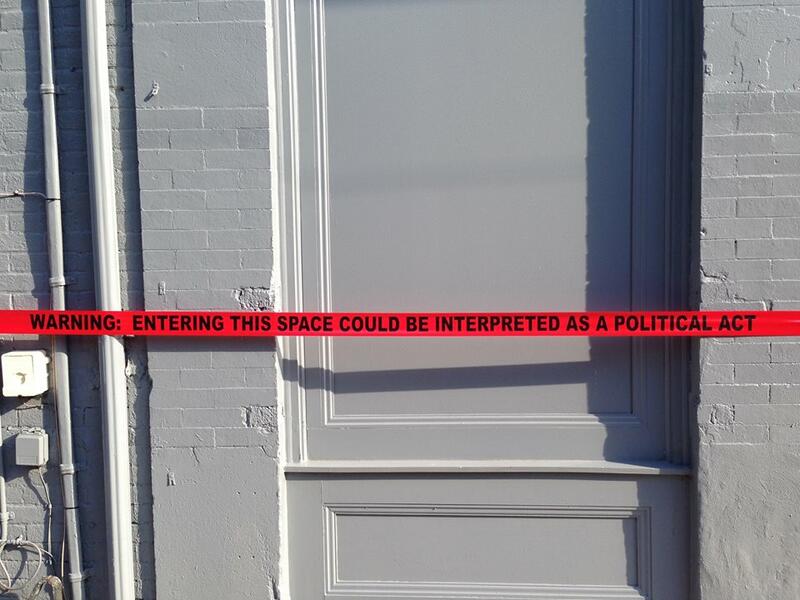 WARNINGThis is the warning tape I had printed for the opening. We ended up wrapping the entire museum in the red tape.
WARNINGThis is the warning tape I had printed for the opening. We ended up wrapping the entire museum in the red tape. -
Israel artist talkIsrael artist talk
-
Palestine artist talkPalestine artist talk
-
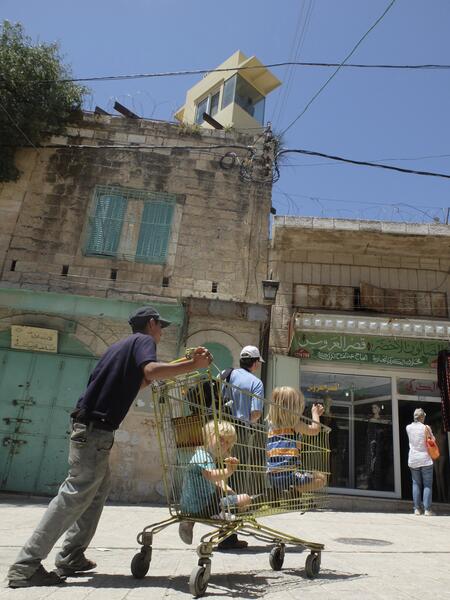 boys in shopping cart in Palestine with Israeli guard aboveboys in shopping cart in Palestine with Israeli guard above
boys in shopping cart in Palestine with Israeli guard aboveboys in shopping cart in Palestine with Israeli guard above -
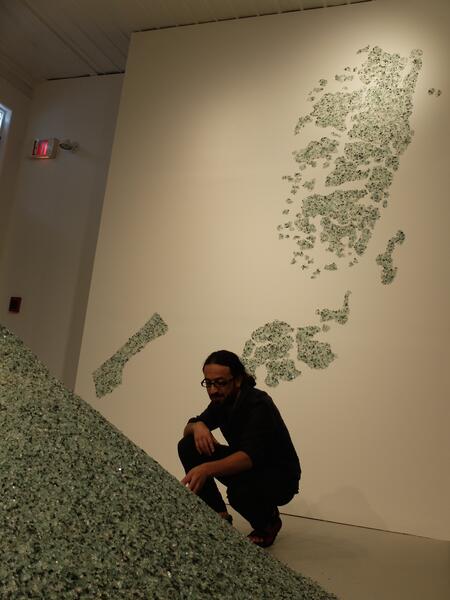 Artists installing work - a fractured PalestineArtists installing work - a fractured Palestine
Artists installing work - a fractured PalestineArtists installing work - a fractured Palestine -
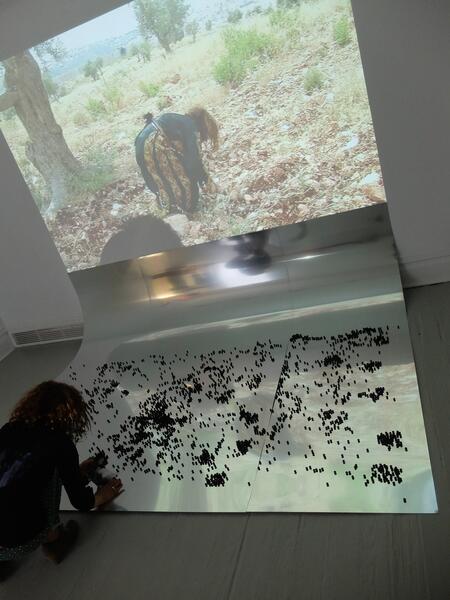 Artists installing- rubber bullets and olive treesArtists installing- rubber bullets and olive trees
Artists installing- rubber bullets and olive treesArtists installing- rubber bullets and olive trees -
Artists installing- Palestinian PassportArtists installing- Palestinian Passport
-
WARNING: entering this space could be interpreted as a political actWARNING: entering this space could be interpreted as a political act
-
Artists Installing- I AM A MANArtists Installing- I AM A MAN
Sites of Passage- CIVIL WRONGS & CIVIL RIGHTS: South Africa and US
As with the other SOP projects, the work builds a virtual and tangible laboratory between artists in South Africa and artists in Pittsburgh. Artists spend time together on the ground in both counties.
Why Now?
As the U.S. moved past its 50th year of the Civil/Voters Rights Act and South Africa moves past its 20th year of democracy/post-apartheid, the project reflects on what we can learn from one another. What is the difference between legal apartheid and economically driven apartheid? What have we done wrong and what have we done right? What has changed? How do our governments, communities and societies discern and apply our past to our present? Are environmental rights the same as human rights? What language do we use to talk about these issues? By meeting with civil rights activists, artist and historians from both countries, the aim is to use art as a platform to expose and address environmental racism and corruption.
Why These Artists?
All the artists confront racial politics via different mediums:
Pittsburgh: We have a sound artist who archives the world around him, a filmmaker who addresses gentrification, and a multimedia artist who brings together myth and futurism to build a new present.
South Africa: We have a choreographer who considers himself a community developer, a print maker/painter who captures the mining towns and uprisings, and a formerly incarcerated drug dealer turned art teacher who is a superhero and role model to the children in the township around him.
-
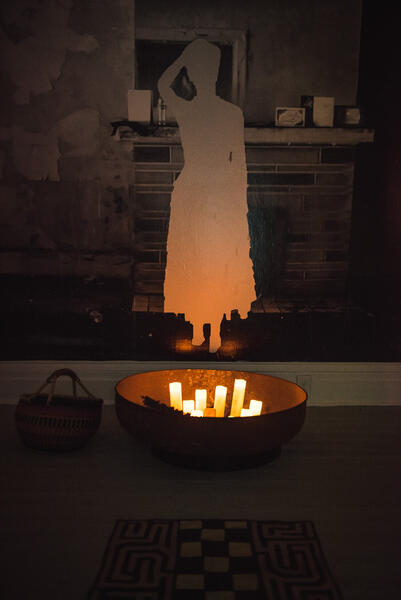 the space I am in: CONJURING, by Alisha Wormsleythe space I am in: CONJURING, by Alisha Wormsley
the space I am in: CONJURING, by Alisha Wormsleythe space I am in: CONJURING, by Alisha Wormsley -
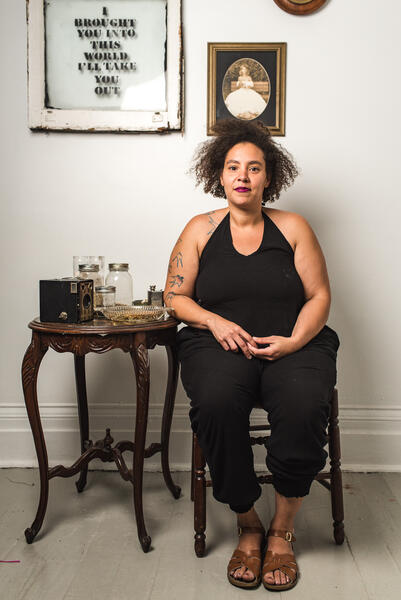 Alisha Wormsely, sitting with the workAlisha Wormsely, sitting with the work
Alisha Wormsely, sitting with the workAlisha Wormsely, sitting with the work -
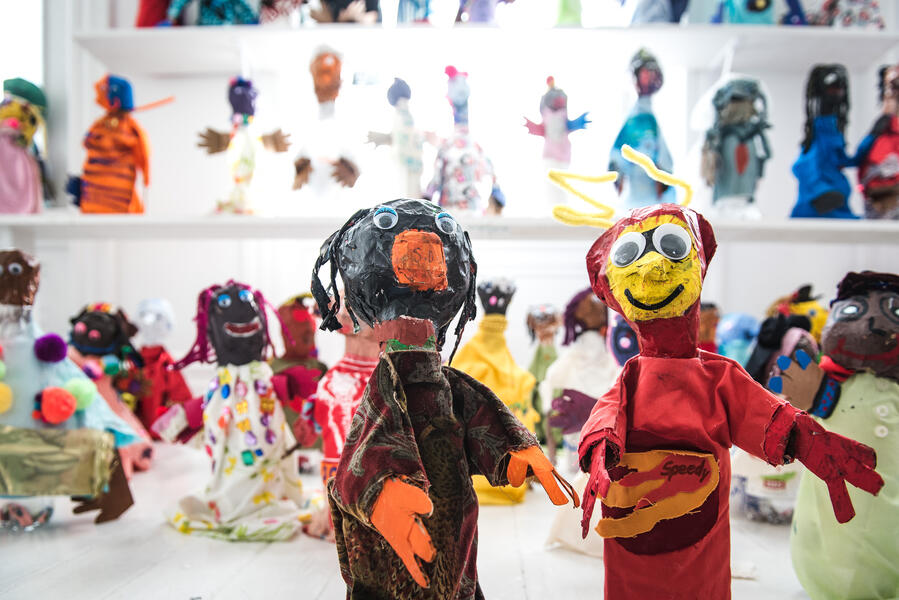 The Superhero Puppet Project fills a room of puppets designed by Baltimore, Pittsburgh and Cape Town young artistsThe Superhero Puppet Project fills a room of puppets designed by Baltimore, Pittsburgh and Cape Town young artists
The Superhero Puppet Project fills a room of puppets designed by Baltimore, Pittsburgh and Cape Town young artistsThe Superhero Puppet Project fills a room of puppets designed by Baltimore, Pittsburgh and Cape Town young artists -
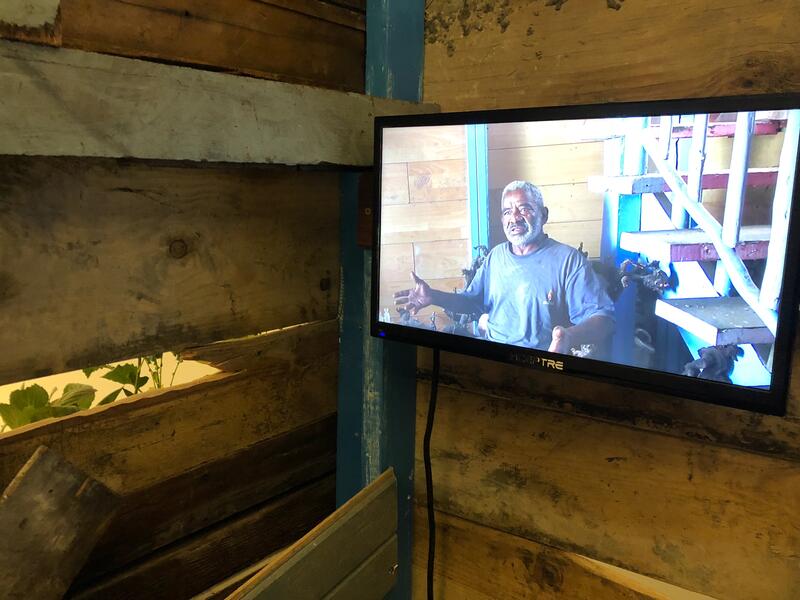 Uncle Fred talks about his journey, his role in the township community and the power of "Dreamland".Uncle Fred talks about his journey, his role in the township community and the power of "Dreamland".
Uncle Fred talks about his journey, his role in the township community and the power of "Dreamland".Uncle Fred talks about his journey, his role in the township community and the power of "Dreamland". -
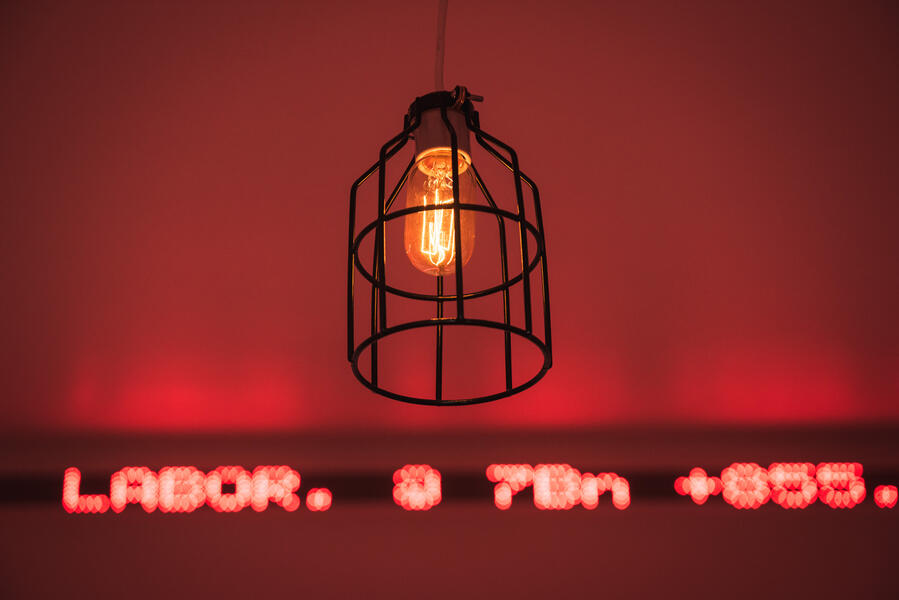 Ricardo Iamuuri's, In The Red: Never Mine, tells the bloody story of the South African mining industry.Ricardo Iamuuri's, In The Red: Never Mine, tells the bloody story of the South African mining industry.
Ricardo Iamuuri's, In The Red: Never Mine, tells the bloody story of the South African mining industry.Ricardo Iamuuri's, In The Red: Never Mine, tells the bloody story of the South African mining industry. -
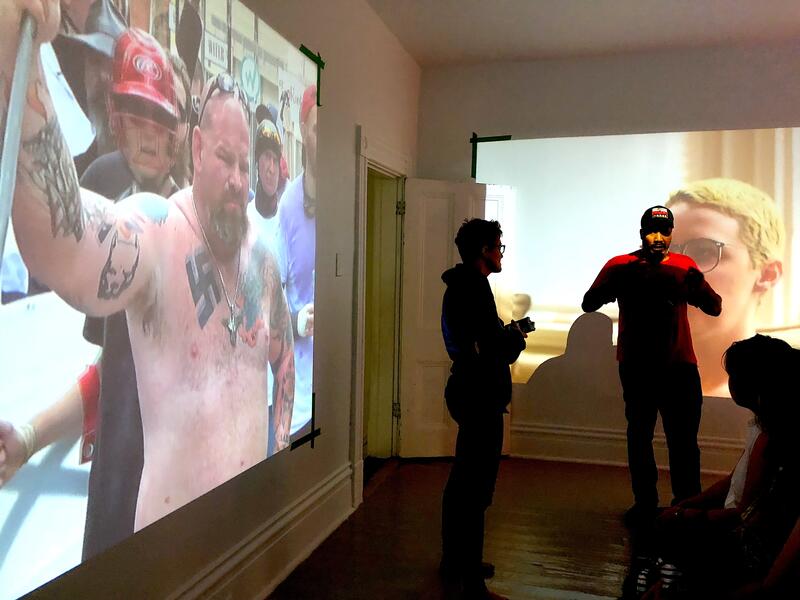 Chris Ivey walks the staff through WE ARE HERE: Finding Beauty in the RawChris Ivey walks the staff through WE ARE HERE: Finding Beauty in the Raw
Chris Ivey walks the staff through WE ARE HERE: Finding Beauty in the RawChris Ivey walks the staff through WE ARE HERE: Finding Beauty in the Raw -
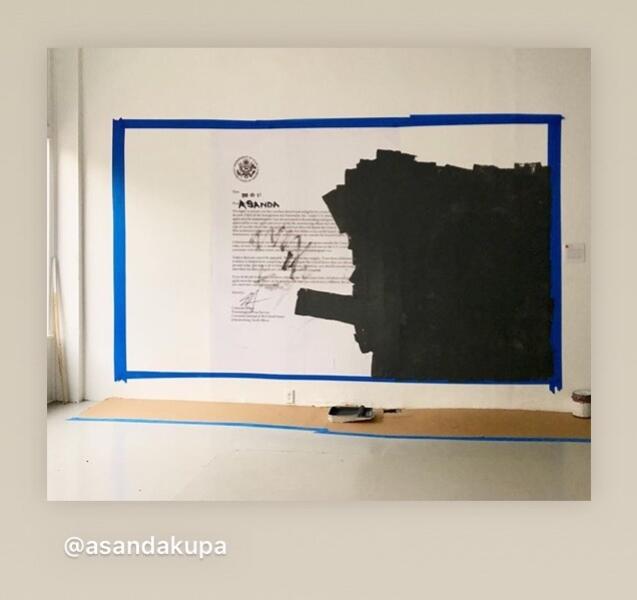 DENIED, Asanda KupaDepending on when you visited Kupa’s Installation, would define what you saw. He was denied entry and was not able to be there for the opening of the exhibit. This is not a new scenario for La Follette, who tried to get Egyptian artists into the US in the middle of a revolution. And much like that project, La Follette refused to take “no” as an answer. If you were at the MF opening night, as soon as you entered the 1414 or MF “annex”, you would find an enlarged rejection letter from the US government on one side of the space and Kupa and La Follette’s emailing back and forth which help to tell the story of DENIED. Kupa, after applying again was awarded a 10 year VISA. This allowed him to come to the museum and paint all over his rejection letter.
DENIED, Asanda KupaDepending on when you visited Kupa’s Installation, would define what you saw. He was denied entry and was not able to be there for the opening of the exhibit. This is not a new scenario for La Follette, who tried to get Egyptian artists into the US in the middle of a revolution. And much like that project, La Follette refused to take “no” as an answer. If you were at the MF opening night, as soon as you entered the 1414 or MF “annex”, you would find an enlarged rejection letter from the US government on one side of the space and Kupa and La Follette’s emailing back and forth which help to tell the story of DENIED. Kupa, after applying again was awarded a 10 year VISA. This allowed him to come to the museum and paint all over his rejection letter. -
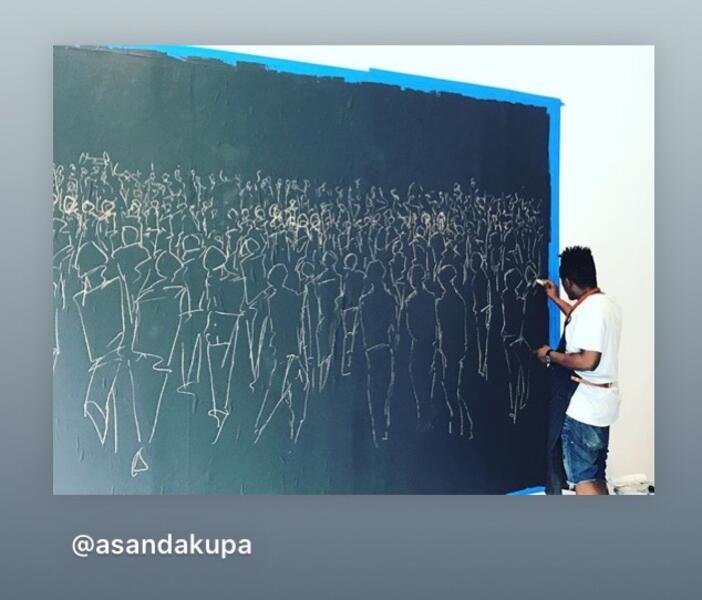 DENIED, Asanda KupaIf you were at the MF opening night, as soon as you entered the 1414 or MF “annex”, you would find an enlarged rejection letter from the US government on one side of the space and Kupa and La Follette’s emailing back and forth which help to tell the story of DENIED. Kupa, after applying again was awarded a 10 year VISA. This allowed him to come to the museum and paint all over his rejection letter.
DENIED, Asanda KupaIf you were at the MF opening night, as soon as you entered the 1414 or MF “annex”, you would find an enlarged rejection letter from the US government on one side of the space and Kupa and La Follette’s emailing back and forth which help to tell the story of DENIED. Kupa, after applying again was awarded a 10 year VISA. This allowed him to come to the museum and paint all over his rejection letter. -
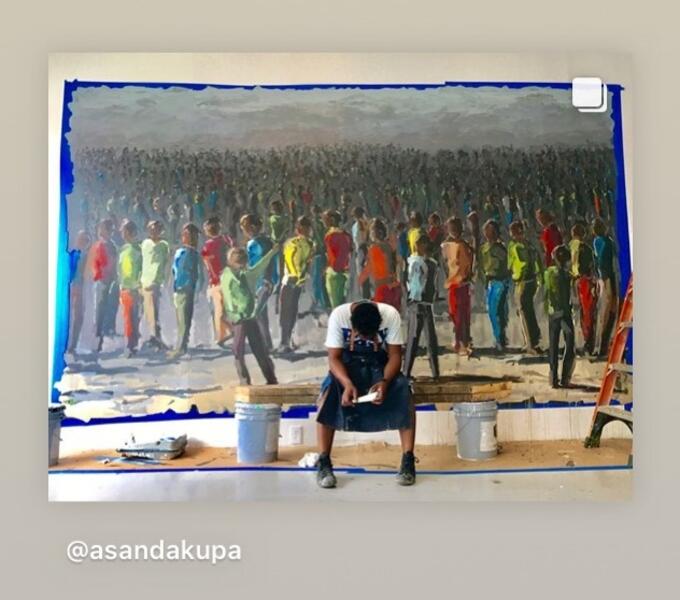 DENIED, Asanda KupaKupa, after applying again was awarded a 10 year VISA. This allowed him to come to the museum and paint all over his rejection letter.
DENIED, Asanda KupaKupa, after applying again was awarded a 10 year VISA. This allowed him to come to the museum and paint all over his rejection letter.
Sites of Passage-POP-AGANDA: Revolution & Iconography, Russia and US
Pop-Aganda: Revolution & Iconography (project in process)
After three research trips to Russia, I have selected six multidisciplinary, social practice-oriented artists in Russia and the U.S. I am currently researching and doing studio visits to add two more artists to this SOP. One from Russia and one from Pittsburgh, PA where the MF museum is located.
All of whom identify as female or are on the gender spectrum.
The curatorial themes, which become the title of the final exhibition and performance series, are left open enough, so that each artist can interpret it as they see fit. Sites of Passage projects are always about gleaning perspectives—both for the artists and the audience.
Propaganda comes from the verb to propagate—to breed or cultivate. However, in the context of the word propaganda, it is about breeding or cultivating an idea to the masses. Cultures, countries, religion and ideologies have been using forms of propaganda since ancient times to disseminate modes of belief.
In an age of disinformation, it is hard to ignore various “realities” spread, bred and cultivated in the name of facts. Propaganda images often proliferate into icons, even defining an entire aesthetic movement. Artists play an important instigative role in this process. For example, Agitprop (from agitate and propaganda) from Soviet Russia, was a visual and simple way of communicating ideologies to the masses. It moved from two-dimensional art to performance. Agitprop theater and the aesthetic spread to Europe and the US. Over time, it became a label for politicized art.
Pop art, similar to propaganda, is designed for the masses. However, unlike the moral ideas that are connected to propaganda, pop art is about the cultural context of the object itself. Both can be considered revolutionary.
The artists will consider the following:
When does revolutionary iconography become pop art, or Agitprop? How does an idea become an icon? When does the spread of an idea reach revolutionary status and who defines this tipping point? How does an idea become a fact?
ARTISTS THUS FAR….
RUSSIA
ANASTASYA KIZILOVA, A researcher, artist, science-fiction writer, was born in 1986. She began her artistic career in 2001 started her education at Stieglitz St. Petersburg State Academy of Art and Industry. In 2013, Anastasya presented the project The Artist Uniform, the aim of which was to interact with the participants of the professional art system. In 2015 she co-organized the horizontal initiative, Flying Cooperation, which unites multi-skilled young artists, who were born in the Post-Soviet space (Belarus, Russia, Ukraine). Since 2016 she has collected an archive of unrealized artists’ ideas entitled Found Project: authors share their ideas for free, so other people who need ideas can realize them. At the moment she works in the field of environmental communication, which focuses on posthumanist and nonhumanist ways of interacting, bringing together theoretical approaches such as queer-ecology, cyberfeminism, bioanarchism and practical methods such as performative creation of an interspecific collective body.
www.anastasyakizilova.com
LERA LERNER, Artist, curator and founder of the Imaginary Museum of Displaced Faces, practices socially engaged art. She researches the processes and ethics of spontaneous communication in an urban environment through performance and installation. Lera
graduated from the Pro Arte Program for contemporary artists and completed the MA program in Curatorial Studies at the Faculty of Liberal Arts and Sciences of St. Petersburg State University. She participated in the Manifesta 10 International Biennial, IV and V Moscow International Biennial of Young Art, 4th and 5th Art Prospect Festival, V International Baltic Biennial of Contemporary Art, VI Ural Industrial Biennial, and the 14th Contemporary Art in the Traditional Museum Festival, and was nominated for the Innovation X prize.
www.cargocollective.com/leralerner
VERONIKA RUDYEVE-RYAZANTSEVA is an observer artist. She belongs to the generation of “children of perestroika”. Brought up on a commune in Siberia, Rudyeva-Ryazantseva was educated via Art College, pedagogy department, St. Petersburg’s Academy of Applied Art and Josef Bakshtain Summer Conceptualism School. She is interested in “man”, issues of identification and everyday absurdity, the connection of the past and present. The heroes of her work are people who become symbols: time, place, generation, event. Rudyeva-Ryazantseva believes art is a territory of experimentation, transgression and does not limit herself to one media, combing video, painting, installation and drawing. Some of her exhibition highlights include, Kurehin Prize 2012, St. Petersburgh, Industrial Biennial of Ekaterinburg 2017 and Waterfront, an eco-project in 2017.
www.veronikarrudye.wixsite.com/mysite
USA
LIZ COHEN is a Photographer and performance artist who (Colombian-American, b. 1973) is best known for her project BODYWORK, in which she transformed an aging East German Trabant into an American El Camino lowrider, and herself into a car customizer and bikini model. Cohen’s earlier work CANAL, a series of black and white photographs and performances, documents sex workers on the fringe of the Panama Canal Zone. In her more recent work, HIM, she depicts an ostracized poet through black and white photographs, weavings, and collaged textiles. Cohen’s work has been characterized as examining immigration, nonconformity, and resistance. Cohen has received awards from the MacDowell Colony, Akademie Schloss Solitude, the Creative Capital Foundation, and the Kresge Foundation. She has exhibited work at Site Santa Fe, Ballroom Marfa, the Cranbrook Art Museum, Färgfabriken, and Museum Tinguely. Her projects have been written about in the New York Times, Art in America and Lowrider Magazine. Cohen received her MFA degree in Photography from the California College of the Arts. She holds a BFA in Studio Art from the School of the Museum of Fine Arts and a BA in Philosophy from Tufts University. She is currently a professor at Arizona State University’s School of Art.
www.salon94.com/artists/liz-cohen
SONYA KELLIHER-COMBS was raised in the Northwest Alaska community of Nome. Her Bachelor of Fine Arts degree is from the University of Alaska Fairbanks and Master of Fine Arts is from Arizona State University. Through her mixed media painting and sculpture, Kelliher-Combs offers a chronicle of the ongoing struggle for self-definition and identity in the Alaskan context. Her combination of shared iconography with intensely personal imagery demonstrates the generative power that each vocabulary has over the other. Similarly, her use of synthetic, organic, traditional and modern materials moves beyond oppositions between Western/Native culture, self/other and man/nature, to examine their interrelationships and interdependence while also questioning accepted notions of beauty. Kelliher-Combs' process dialogues the relationship of her work to skin, the surface by which an individual is mediated in culture. Kelliher-Combs' work has been shown in numerous individual and group exhibitions in Alaska, the United States and internationally, including the national exhibition Changing Hands 2: Art without Reservation and SITELINES: Much Wider Than a Line. She is a recipient of the prestigious United States Arts Fellowship, Joan Mitchell Fellowship, Eiteljorg Fellowship for Native American Fine Art, Rasmuson Fellowship and is a recipient of the 2005 Anchorage Mayors Arts Award and 2010 Alaska Governor's Individual Artist Award.
www.sonyakellihercombs.com
EMILY NEWMAN was born in Singapore in 1977, raised in the UK and is currently based between Pittsburgh, Pennsylvania and St Petersburg, Russia. She received her MFA from CalArts in 2004 and has shown internationally including at the Taylor De Cordoba gallery in Los Angeles, the Anna Akhmatova Museum in St Petersburg and the Klaus Von Nitchtssagend Gallery in New York where she has been represented since 2004. Her work has been critically reviewed in publications such as Art Review, The Los Angeles Times and Artforum Intl, where she has contributed reviews since 2007. Her latest works draw from her time spent in Russia and explore methods of attaining historical and self-knowledge through model-building and imaginative reconstruction. She received a Fulbright in 2006 and spent three years teaching at The Finnish Academy of Fine Arts and at St Petersburg University, where she headed a fledgling a program in Contemporary Art at Smolny College. She is currently the director of TOKAMAK, a structured residency for artists which takes place every summer on the island of Suomenlinna, within the framework of the Helsinki International Artists’ Exchange Program (HIAP).
www.emilynewmanartist.com
Documenting the Journey
Director/Curator, Tavia La Follette, has ask Susanne Slavick to travel with the group. Slavick, who traveled to Egypt, Israel and Palestine via previous Sites of Passage projects has a great understanding of the process and has seen all of the various incarnations.
Susanne Slavick is an artist, curator and the Andrew W. Mellon Professor of Art. Slavick’s work pursues empathic unsettlement through images that remind us of what we stand to lose after what we have lost already. She has exhibited internationally, with more recent solo shows at the Chicago Cultural Center, McDonough Museum in Youngstown, Accola Griefen Gallery in New York, and Bernstein Gallery at Princeton University. She studied at Yale University, Jagiellonian University in Krakow, and Tyler School of Art in Rome and Philadelphia. Her work has been recognized by the National Endowment for the Arts and through four awards from the Pennsylvania Council on the Arts.
When & Where
La Follette has been invited back to the MF to curate this 4th Sites of Passage project, scheduled to open in May 2021.
The Mattress Factory (MF) is a museum of contemporary art that exhibits room-sized works called installations. MF houses the artists, co-produces the installations and performances with ArtUp. More information at www.mattress.org
Each project takes about 2-3 years to execute. One cannot go into these exchanges in a naïve manner. This time that is needed to research, curate and fundraise. SOP is funded via the non-profit, ArtUp, www.artup.org.
-
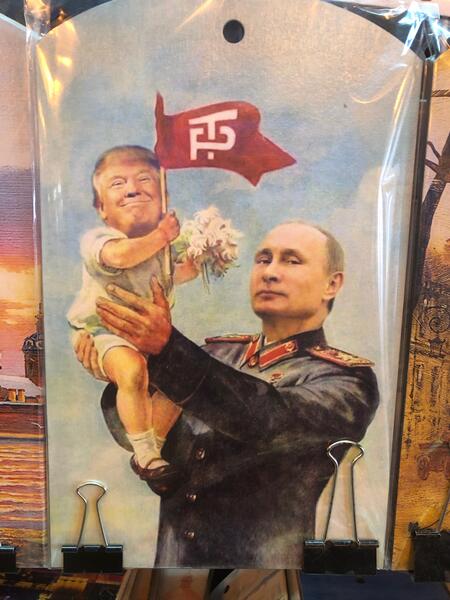 Trump Putin paraphernalia-propagandaJust like in the US, it is easy to find Putin paraphernalia, T-shirts, posters, hats, calendars etc. It is a tourist business. What has changed in my past 3 trips to Russia, is the amount of Trump and Putin combo paraphernalia.
Trump Putin paraphernalia-propagandaJust like in the US, it is easy to find Putin paraphernalia, T-shirts, posters, hats, calendars etc. It is a tourist business. What has changed in my past 3 trips to Russia, is the amount of Trump and Putin combo paraphernalia. -
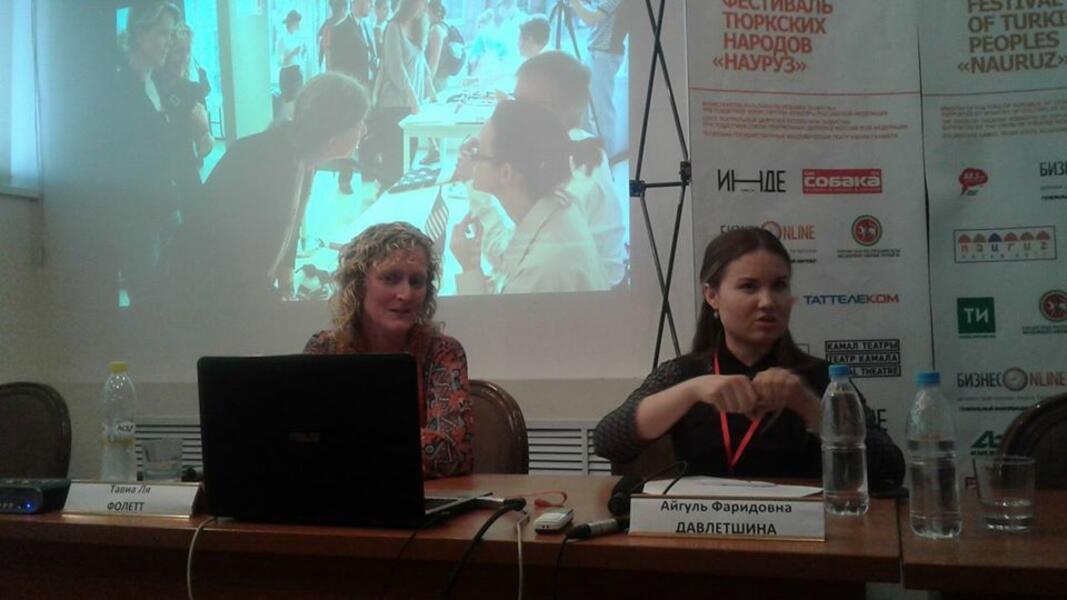 Presenting the SOP work in Kazan, RUPresenting the SOP work in Kazan, RU
Presenting the SOP work in Kazan, RUPresenting the SOP work in Kazan, RU -
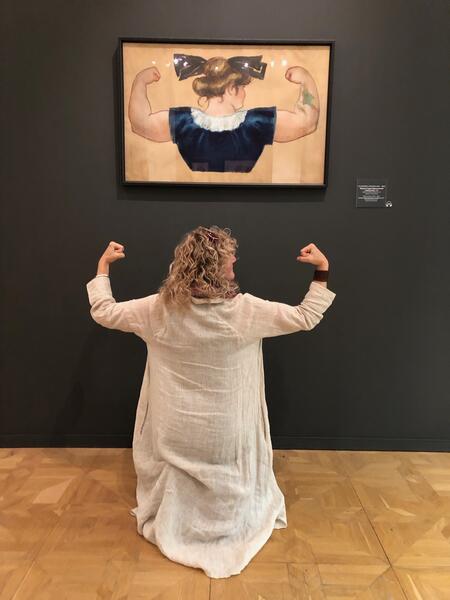 Strong Russian WomenTrying to blend in at the Hermitage
Strong Russian WomenTrying to blend in at the Hermitage -
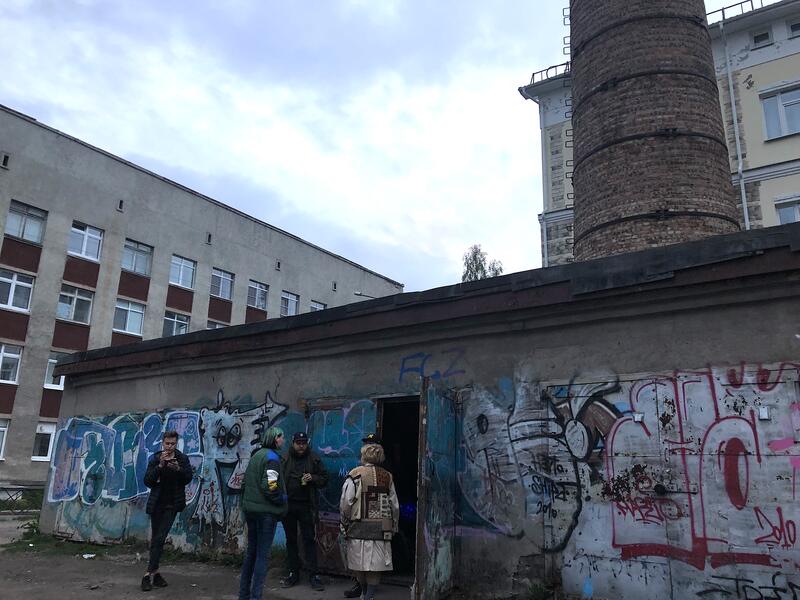 Subversive Art in Storage UnitsGetting a taste of the underground art scene
Subversive Art in Storage UnitsGetting a taste of the underground art scene -
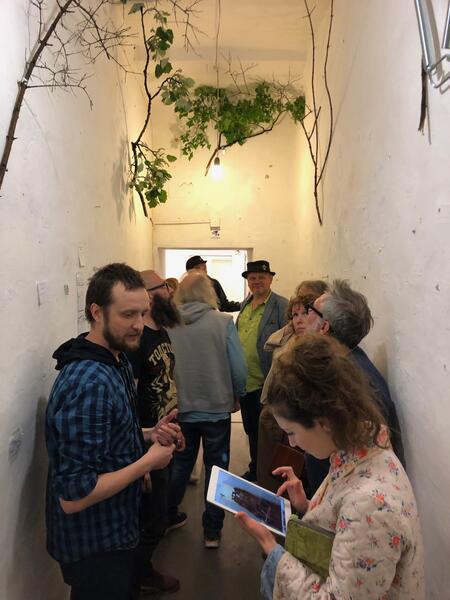 1. A St. Petersburgh arts collective takes of the hallways of a gallery to show work. They are about to de-install.1. A St. Petersburgh arts collective takes of the hallways of a gallery to show work. They are about to de-install.
1. A St. Petersburgh arts collective takes of the hallways of a gallery to show work. They are about to de-install.1. A St. Petersburgh arts collective takes of the hallways of a gallery to show work. They are about to de-install. -
Playing at the White Sea 1Playing at the White Sea 1
-
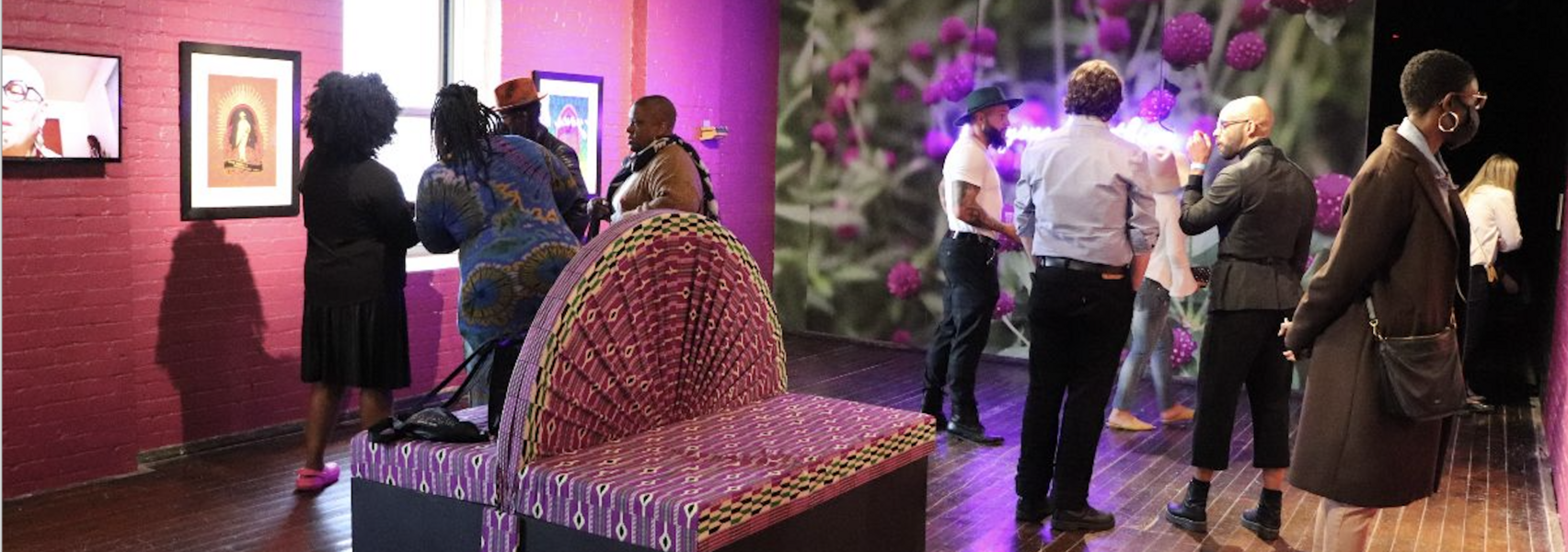 News_ PopAganda OPENING
News_ PopAganda OPENINGBekezela Mungi exhibit
-
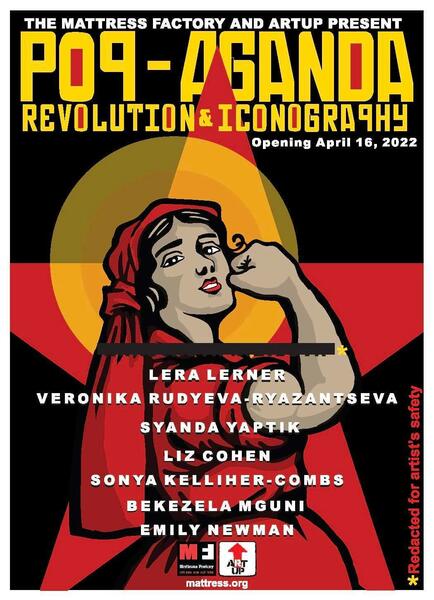 Exhibition Poster
Exhibition PosterPopAganda poster
-
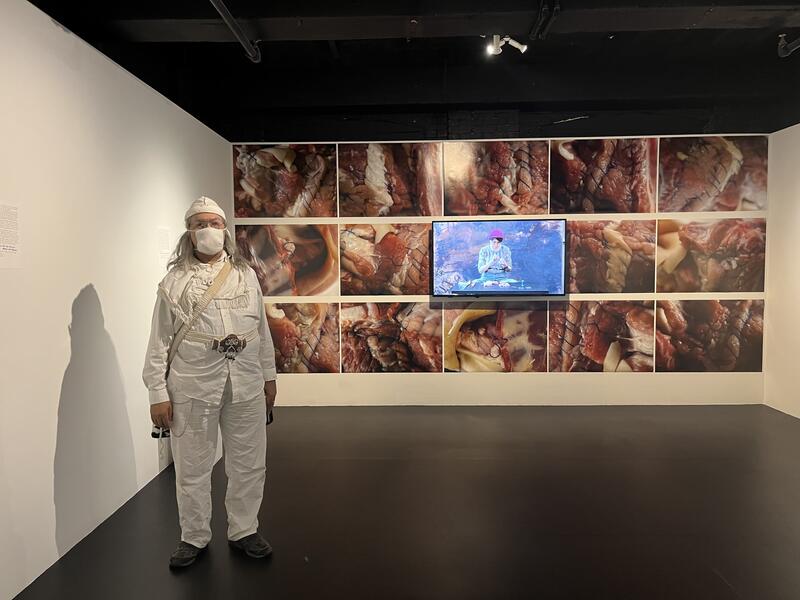 Syanda Yaptik installtion
Syanda Yaptik installtion -
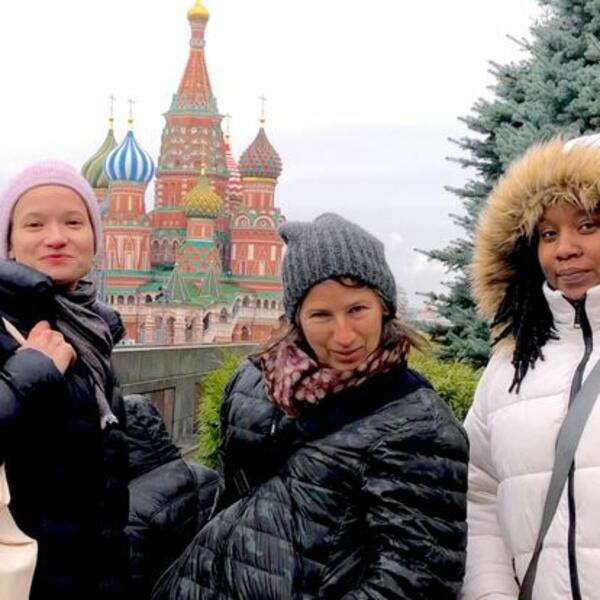 Traveling Russian/US artists
Traveling Russian/US artists
Cultural Ecology& ARTifacts
Cultural Ecology& ARTifacts: Meaning Making with Elders is designed as a collaboration with Elders and community to address the impact of plastics and garbage on the village of Badanga. This site-specific performative installation project is open to community and is aimed to teach guardianship, conservation and reciprocity while reflecting on the actions of our ancestors: the sacrifices made, and the cultures lost.
The project is deliberately structured toward the next generation of art practitioners, how to address Western Colonial Systems and why they have caused so much destruction to the planet.
All local community members are invited to join the residency/workshop to honor relationships with their own history and share cultural values with the students. Through community workshops and Site-Specific performance, a final performative piece will culminate the project. It will have a digital living life. The act itself is a form of performance and social practice.
All of my workshops are open to observation and can happen in outdoor spaces (weather permitting). Therefore, they can be observed at all times by community. In the workshops the materials are cheap, collected and gathered from one’s own home or via recycled objects and garbage. The village and its Knowledge Keepers are the stimulus for the project.
-
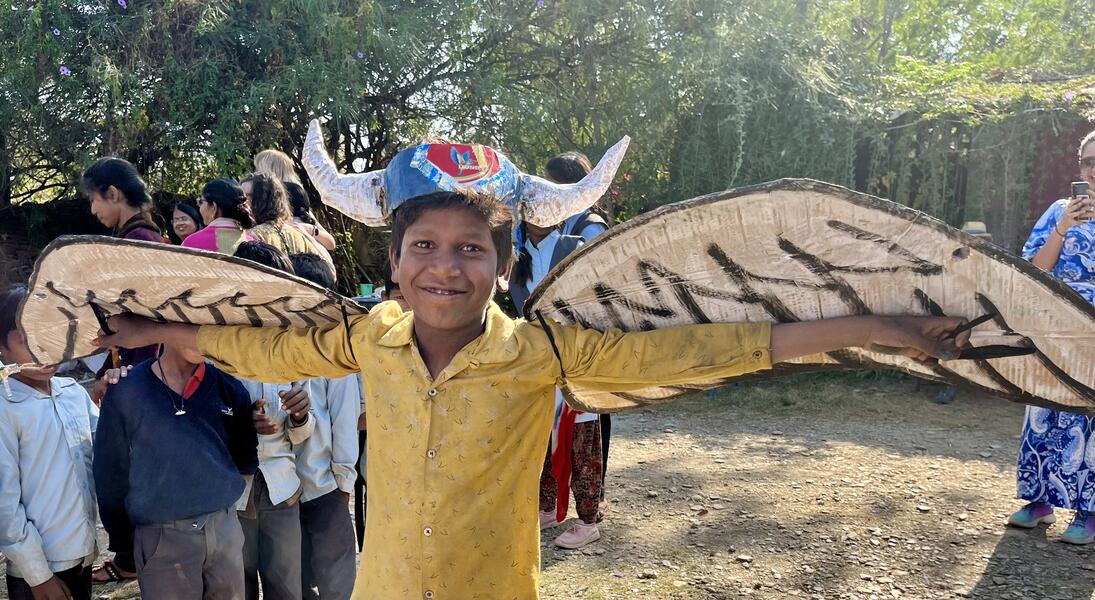 Winged cow spirit 1
Winged cow spirit 1 -
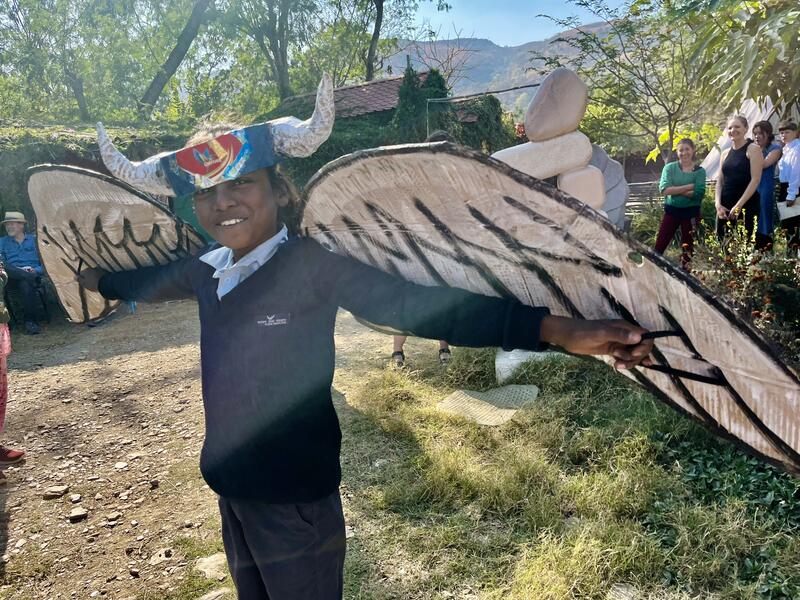 Winged Cow Spirit 2
Winged Cow Spirit 2 -
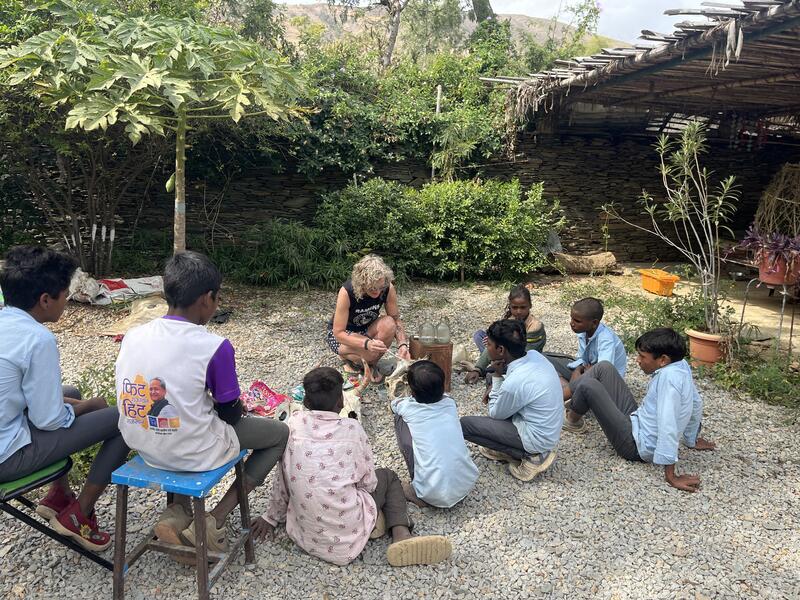 Cleaning the collected garbage for art making
Cleaning the collected garbage for art making -
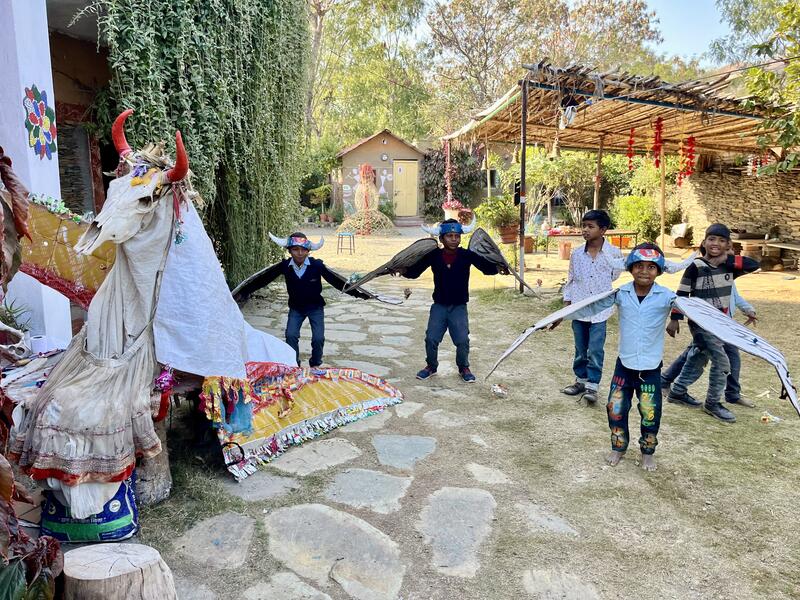 Rehearsing with the cow spirits
Rehearsing with the cow spirits -
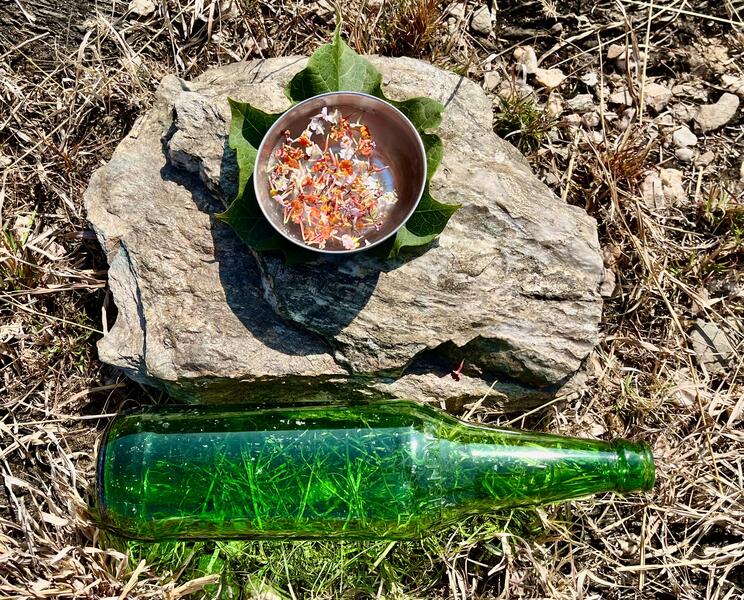 Ritual before the performance
Ritual before the performance -
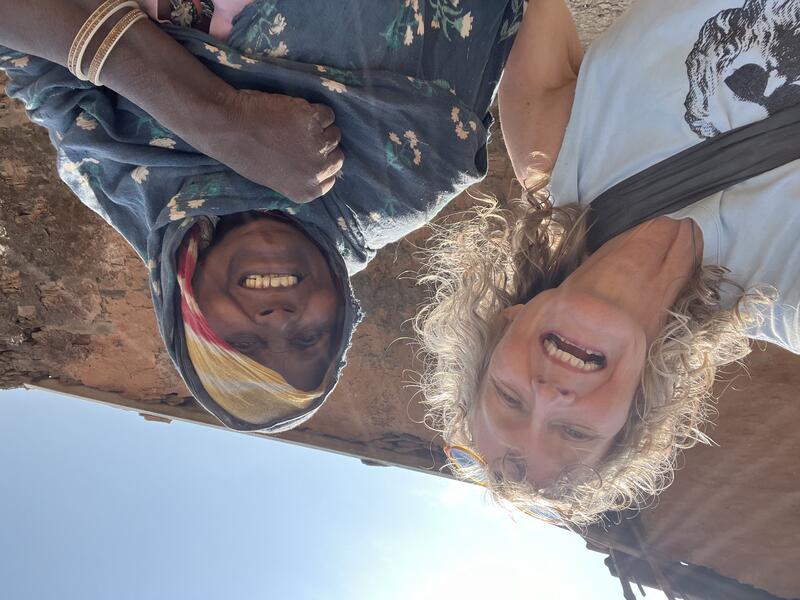 Making friends and learning stories from the elders in the village
Making friends and learning stories from the elders in the village -
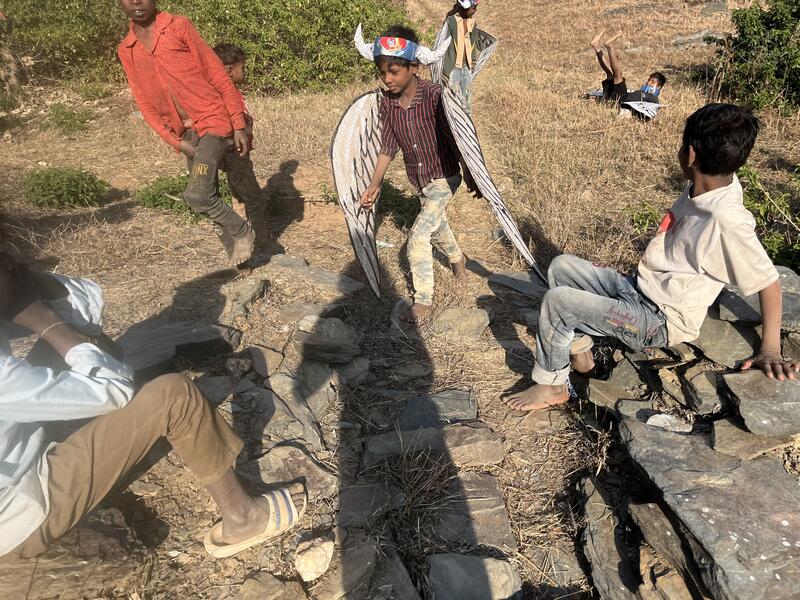 Site- in the fields
Site- in the fields -
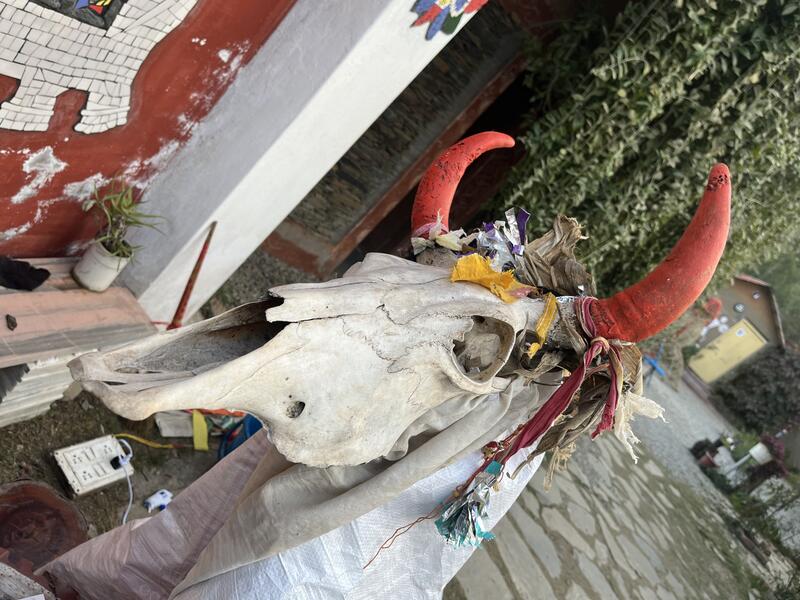 Scared Cow Head puppet
Scared Cow Head puppet -
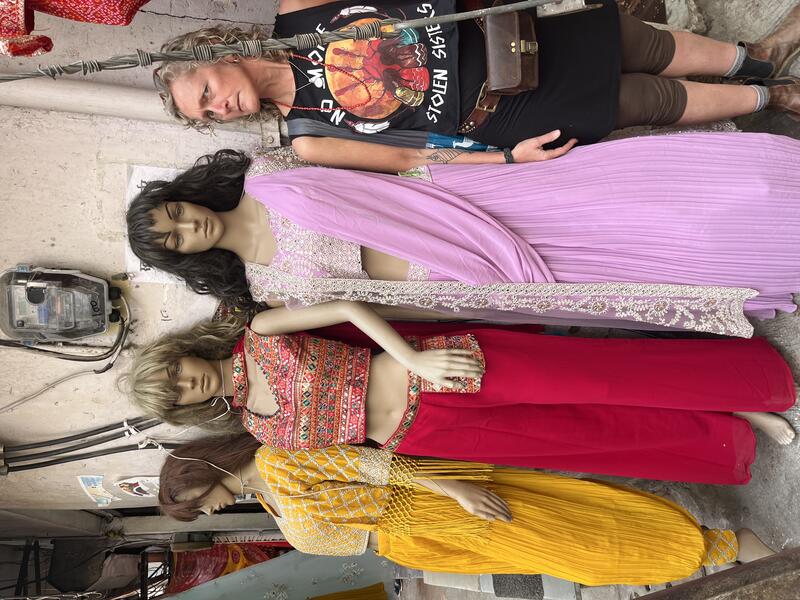 Trying to blend in
Trying to blend in -
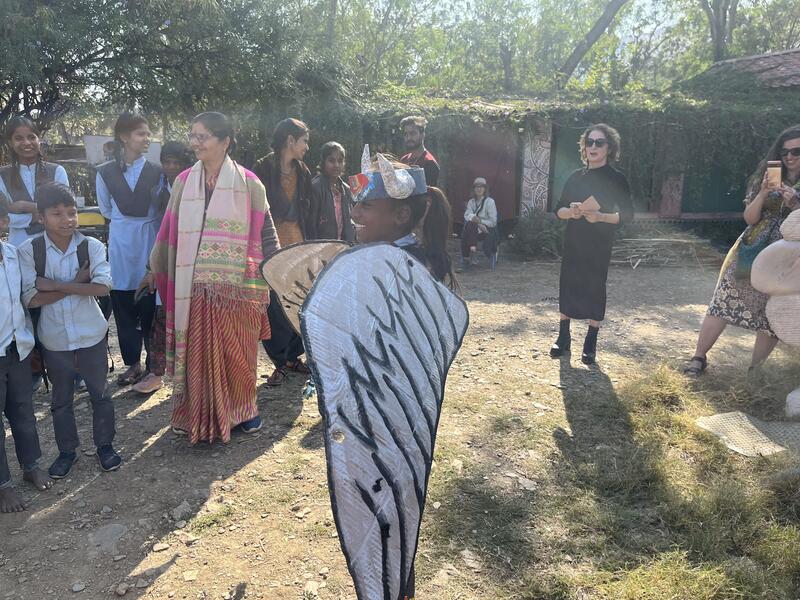 Rewards of a successful performance 1
Rewards of a successful performance 1
When the Butterflies Would Visit
INSPIRATION “When the butterflies would visit” (WTBWV) is a line from the play, THE INVENTION OF SEEDS, by Analisa Dias (participating mentor). These are the words of an Elder, a South African grandmother, who haunts a goldminer grieving with The Center of the Earth, another character in the play. In this play/project, we are ALL the center of the Earth. The “Seed” portion of the play will be performed with Guna community, culminating the 2-week residency/fellowship in Armilla, Panama.
GENERATIONAL WTBWV is the first convening of ten ecological artists/activists/fellows on Indigenous land in the Guna territory of Panama. Designed to empower the next generation of ecological BIPOC artist/researchers, we seek new ways of working based in community, ecology and nurturing structural change. Exploratory research includes medicinal plants, marine biology, social practice, ecology, the migration crisis (Guna territory is the only crossing point), and the environmental microplastic crisis and nurdles (more info: https://environmentamerica.org/pennsylvania/articles/what-are-nurdles/). In exchange of precious sacred knowledge, WTBWV residents build prototypes/pilot projects which address both environmental and societal issues caused by western practices.
THE Why? This project is feeding two birds with one hand. It helps feed outside ecological ideas to the Guna people, addressing their current struggles around plastic and human migration (a crossing point), while also allowing social practitioners (artists/scientist/activists) to work hands on with BIPOC mentees, building a new generation of practitioners.
Reciprocity, something western culture desperately needs to work on, is the social psychological practice of ecology. If we as westerners, can shift from capitalistic colonial systems to indigenous practices of living in relationship to the living beings around us, humanity just might have hope.
However, this Indigenous knowledge is getting harder to keep and pass down-- as western culture's failures infiltrate and seep into the community. Plastics from across the world wash up onto the free state’s shores, riddling the beach with plastics which end up inside of everything and everyone. Our hope is that when the younger generation of the Guna see the younger generation of the America's coming to Armilla to study, they will find pride in the work and decide to stay -- instead of leave to the city.
This opportunity will directly impact Favio and Desy, who are the Guna leaders of this project, both enabling them to speak and spread the word about the communities' struggles, while also helping them financially.
This opportunity also allows the next generation of BIPOC social practitioners to get hands on experience in the field.
-
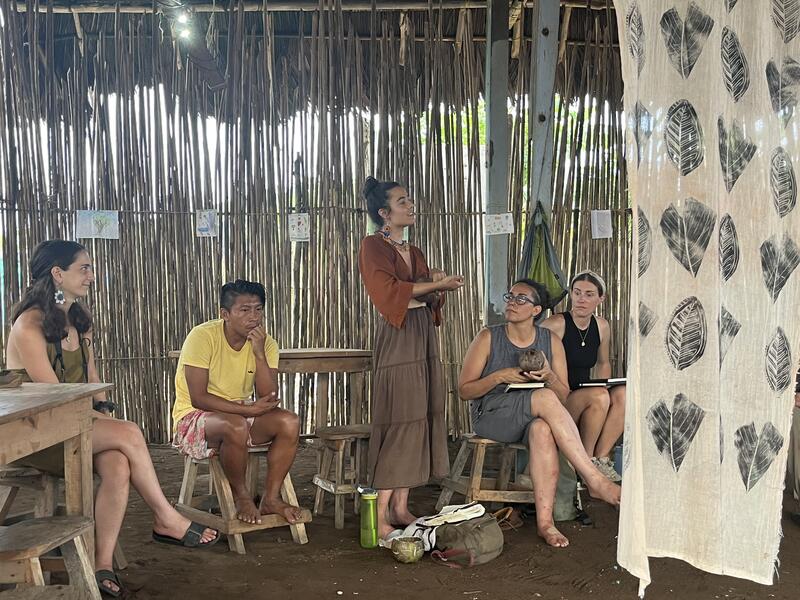 Presentations with Community
Presentations with Community -
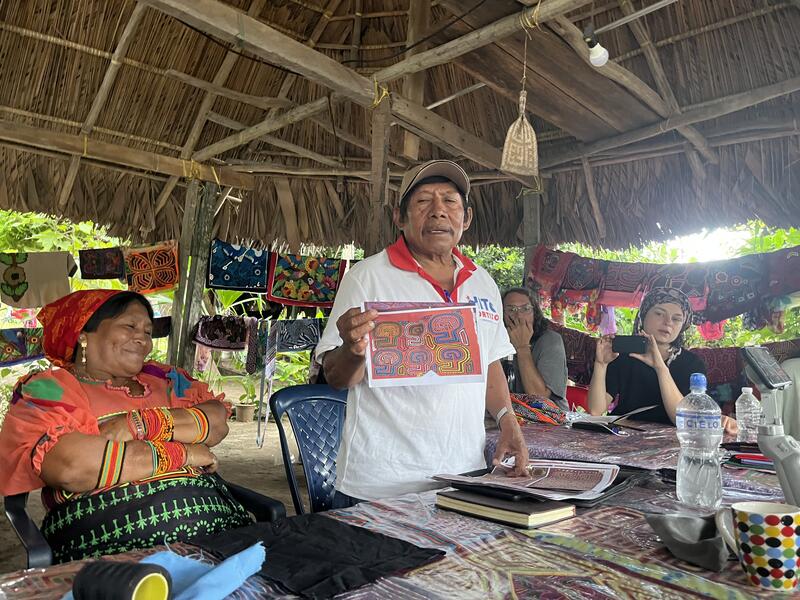 Mola Workshops- Molas hold the ecological recipes passed down from generations
Mola Workshops- Molas hold the ecological recipes passed down from generations -
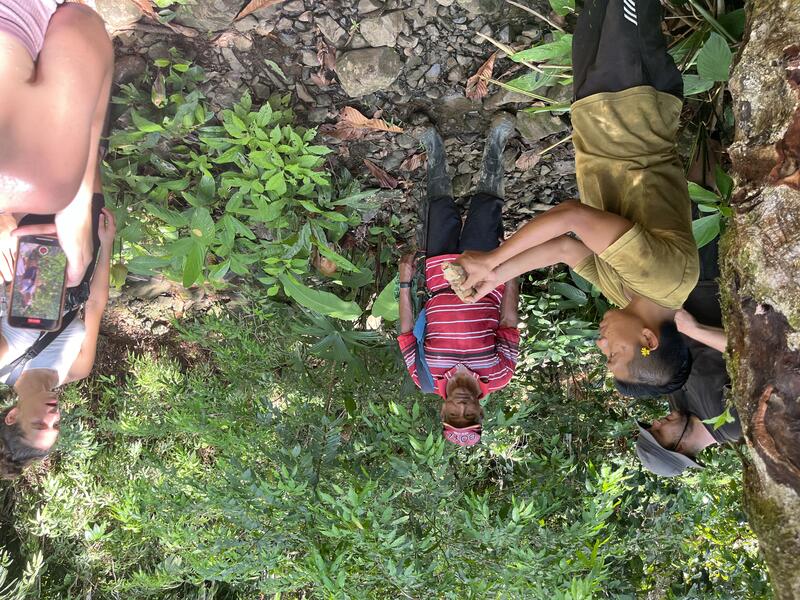 Walking withe Medicine Man
Walking withe Medicine Man -
 Western Waste Washed Ashore
Western Waste Washed Ashore -
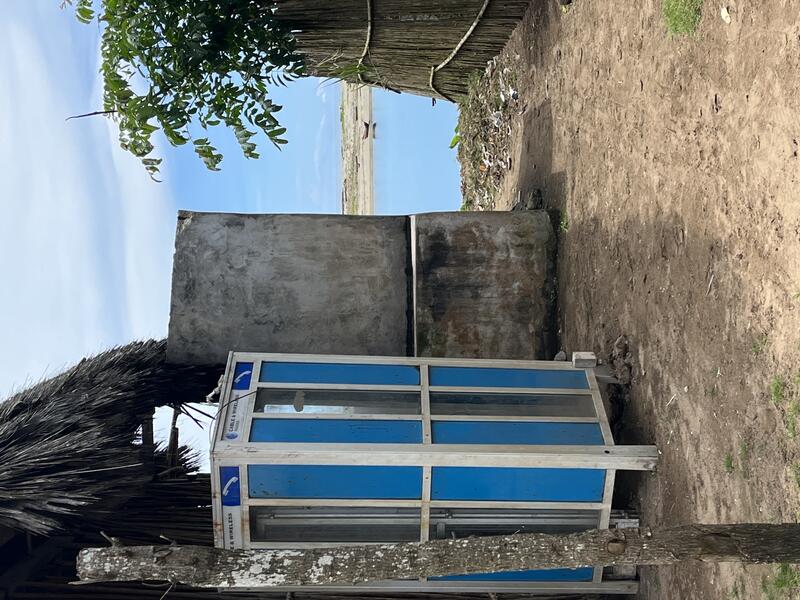 Western Waste Washed Ashore 2
Western Waste Washed Ashore 2 -
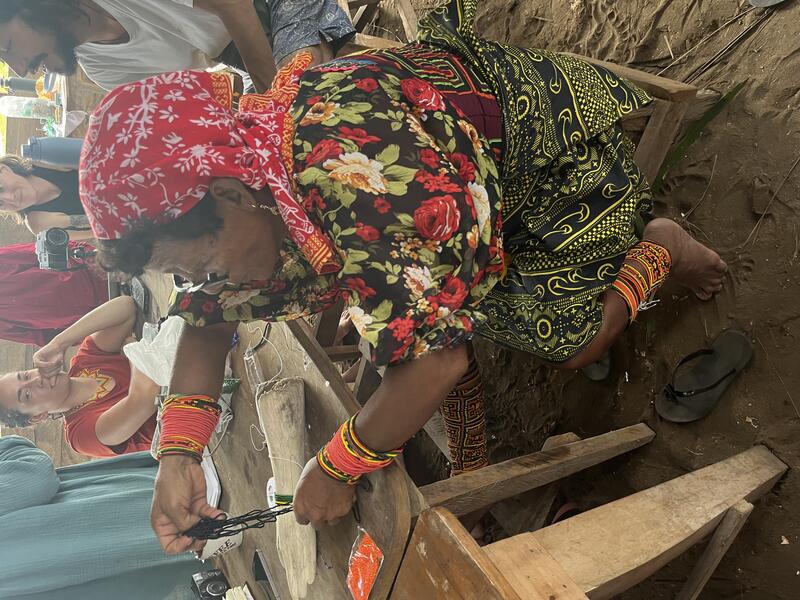 Women winny (beaded record keeping) making
Women winny (beaded record keeping) making -
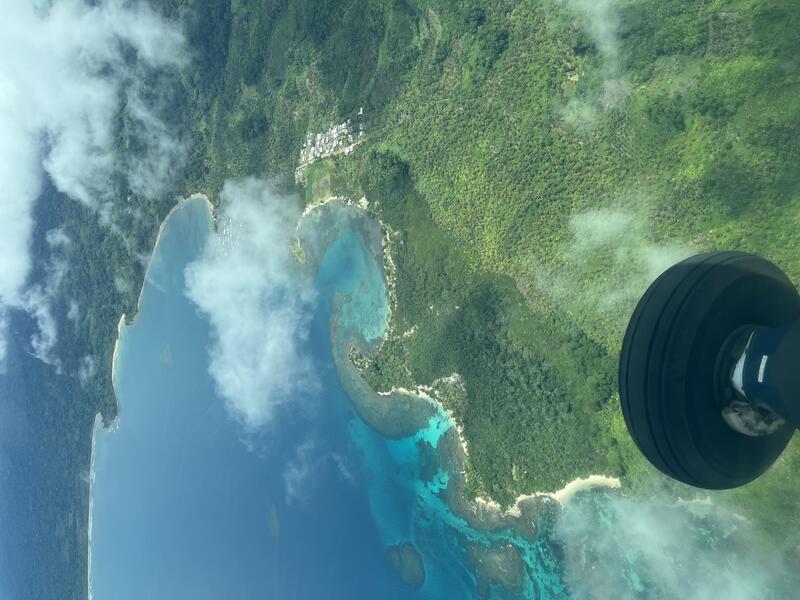 Armilla can only be reached by plane or boat
Armilla can only be reached by plane or boat -
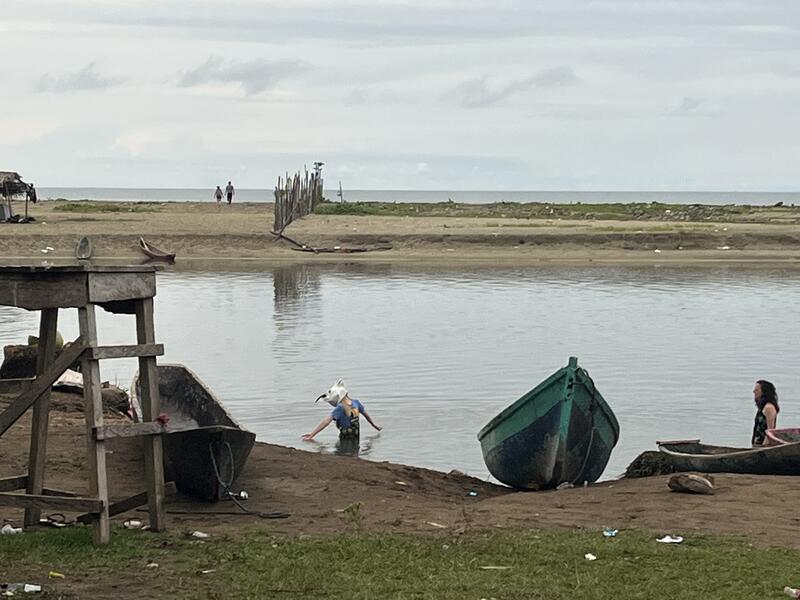 Playing with performance
Playing with performance -
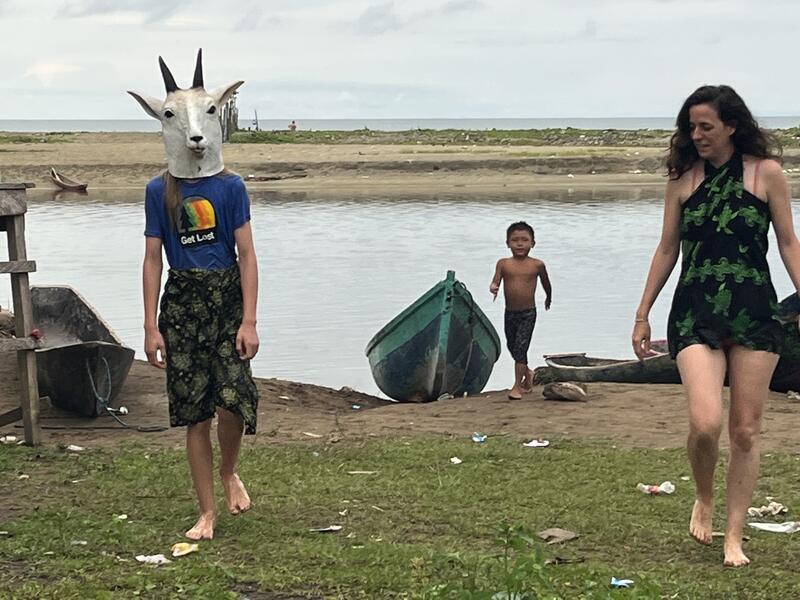 Playing with performance 2
Playing with performance 2 -
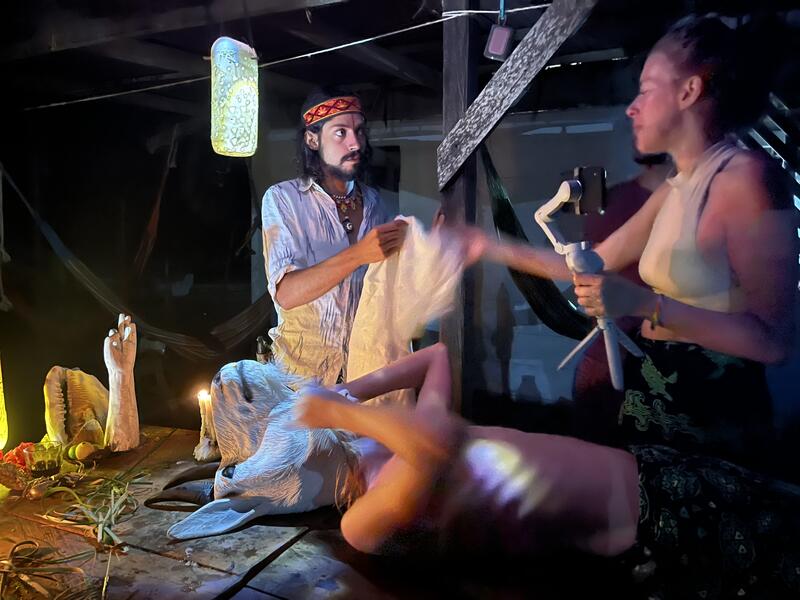 Playing with performance 3
Playing with performance 3
THE END OF THE WORLD PROJECT
WHAT Crossroads I will use my expertise as a curator, networker, culture crosser and social partitioner to build an exhibition with, and for the community. Through an auto-ethnographic lens, I will translate the knowledge gained from my time with ICArEHB (Interdisciplinary Center for Archaeology and the Evolution of Human Behavior) into an interactive installation. This will be accomplished by shadowing João Cascalheira, the director and his team for four months in the spring of 2026. This translation will manifest into a final exhibition and performance series, open to the public, performed with students and community members. While in Portugal, I will produce artist talks, workshops, classes and mentoring opportunities to build a network of partners/collaborators who will help bring this project to fruition. I have made a career from producing similar border crossing projects. Please see the portfolio section of this application for examples of this cross-cultural work.
Theatre and the Arts have long been recognized as a tool to reflect upon and shape society. The influence of Greek Theatre on western civilization is hard to dispute. In an era when press and media was not yet a form or a forum, the practice of theatre is how conversations were brought home to dinner tables. This theater, tied to religious/spiritual rituals, also served as a moral compass for society. Shakespeare asks us to hold a mirror up to our human nature. Bertolt Brecht takes it further (as I do), asking us to use the artistic tool not only to see our reality—but to re-shape it. Pablo Picasso, whose work, as legend has it, was greatly impacted by the bison cave paintings in the Altamira cave in Spain. His anti-war painting, Guernica, the bull symbol is prominent and executed in his well-known “primitive” manner.
This use of symbolism and metaphor (taken from Greek, meaning to transport) is how we will transport the audience to the important work of the Interdisciplinary Center for Archaeology and the Evolution of Human Behavior. The first sentence in João Cascalheira’s biography states, “I am an archaeologist interested in prehistoric hunter-gather adaptations, specifically in how these are related to processes of climate and environmental change”. This is where our research roads cross. This is where our project begins.
The crossroads is where ICArEHB and my passions meet to build the goal of this project: To translate the center’s work into digestible material through installation and performance. Designed as an accessible space to reflect upon humanity’s current growing pains of cultural evolution – while holding a mirror up to our past cultural behaviors in the times of great shifts in human migration, climate change, and disease.
WHERE Context of Space & Place According to legend, “the end of the world” is the southernmost region of Portugal (the end of Europe), where a variety of migrating and colonizing communities (Neolithic, Phoenicians, Greeks, Carthaginians, Romans etc.) worshiped their gods as they watched the sun sink, hissing into the oceanic abyss. Strabo, the Greek geographer and historian describes how no one dared sleep on this scared ground, as this is where the gods would gather at night.
The Romans called it “Promontorim Sacrum”, or “Sacred Cape”. The Muslims of Iberia called it “west of Andalusia” (Spain). Under the Moors occupation, translated from the Arabic “gharb al-ʼandalus” or “غرب الأندلس” was shortened just “al-Gharb” and it is now known as “The Algarve”.
This hallowed land is where prehistoric culture erected megaliths, large stone structures of tombs, alignment circles, and standing stones. Here, is also one of the last holdouts of the Neanderthals—before they were made extinct.
What happened to our relatives, who left Africa much earlier than us Homo Sapiens? What role did our evolution play in their disappearance? Due to revolutionary advancements in paleoanthropology, our understanding of this creature, who homo sapiens have mythologized, has shifted immensely and can give insight into humanity’s own path to extinction.
HOW Importance of relationships Working with Indigenous communities has taught me the power of relationships. Othering is not part of the Indigenous Ways of Knowing. In most languages there is no word for “it”, as all things share life, come from the land, and are part of the same family. Therefore, all things are created equal. There is no hierarchy. This is the foundation of the circular path of relationship and reciprocity.
My work with the Indigenous has profound crossover with this project, as both are driven by the need to address humanity’s past behaviors—to adapt and live in a more ecologically harmonized way with the planet. This proposal is propelled by the need to reflect upon humanity’s current growing pains of cultural evolution. Indigenous Knowledge centers the earth. And our earth holds the history of our evolving humanity. Something our archeologists’ partners have made a life of.
This is not the first time the center has had a colleague from another field join their team. Prior to this project, ICArEHB had a psychologist who, like me, shadowed their archeological work and was able to apply it to his ideas around children and their fear of the dark. He was interested in connecting our cave dwelling days of the Ice Age to this innate fear of the dark.
I enter this work after holding positions in several academic centers and as the founding director of CoLab. This will not be the first time I am in residence nor is it the first time that ICArEHB has hosted across disciplines. This project is a marriage of a center and an artist/academic who processes of discovery are in harmony. It is a reciprocal relationship in the sense that ICArEHB is sharing their meaning making process with me. In turn of this great gift of knowledge, I will translate that meaning into a public exhibition (interviews, installation, film and performance) of community self-discovery.
WHY NOW Civilization Collapse Scientist are gaining a deeper understanding of how human history is an outcome of our own environment. Back in 2020, when trying to make sense of COVID 19, I, like many others looked to the past to try to make sense of the present. In doing so, I became obsessed with the Bronze Age collapse. In just a generation, multiple societies around the Mediterranean collapsed—losing languages and writing systems, huge swaths of culture were left without any context to why all these great first civilizations fell simultaneously.
Finally, we have reached an age, where fields can talk with each other—where we can share information and ideas across disciplines. This has led to the understanding that the Bronze Age Collapse was a perfect storm of climate change, disease, and human migration. Sound familiar?
However, this time we are addressing man-made climate change (greenhouse effect) of which we are only just beginning to see the impacts of. Prior to 12,000 years ago, hunter-gathers, like our cousins the Neanderthals, we spent around two million years as nomadic creatures who traveled in small bands. These small numbers gave us agility to move quickly and adjust to the environment around us. We have lost this agility as we are roughly one hundred times larger than compared the population at the height of the Roman Empire. Our large cities of today with no evacuation sequence is reminiscent of the Bronze Age Collapse.
THE QUEST-ION Cultural Evolution By sharing across disciplines, through a “hive mind”, we gain new perspectives which influence our future ideas. This cross-pollination replaces an old way of working—parallel but separately from one another. In this new movement, we are using one other’s work as springboard for our own investigation.
The “transdisciplinary” approach allows us to adapt our ideas in development with other ideas, building that same culture of adaptability we had as nomadic creatures. This evolutionary adaptability will be key to our survival. Nations will have to share information and work together, as the impact of global warming alters the land we live on.
Nations will need to shift our way of thinking and start forecasting generations ahead, a common trait of Indigenous cultures. How can we make amends, prepare ourselves and set the stage to give our future generations an opportunity to thrive in a rapidly changing environment?
As the cultural theorist and anthropologist Clifford Gertz says, “Culture is public because meaning is.” Therefore, we are the meaning makers. We now have an opportunity to build knowledge, together, across borders and share it with the public to build a new culture of sustainability and in harmony with the planet. A culture of agility, that recognizes and shares our past mistakes in order to adjust towards the future. It is our job as scientists, artists, and meaning makers to help spread these ideas towards a common catharsis—a mutual understanding.

